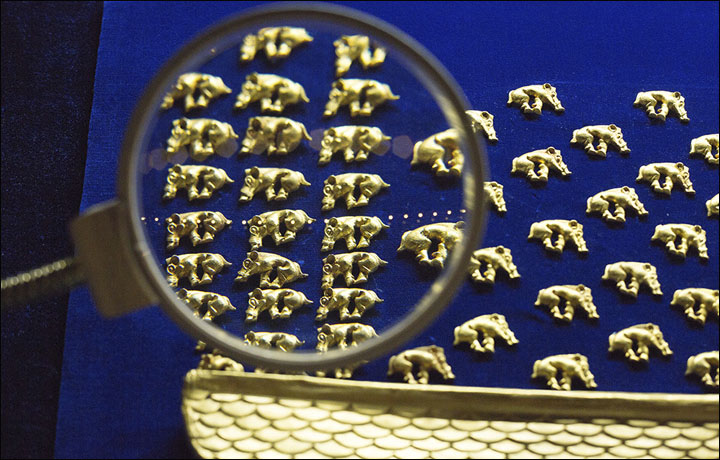The Scythians
Printed From: History Community ~ All Empires
Category: Regional History or Period History
Forum Name: Steppe Nomads and Central Asia
Forum Discription: Nomads such as the Scythians, Huns, Turks & Mongols, and kingdoms of Central Asia
URL: http://www.allempires.com/forum/forum_posts.asp?TID=31061
Printed Date: 20-Apr-2024 at 01:24
Software Version: Web Wiz Forums 9.56a - http://www.webwizforums.com
Topic: The Scythians
Posted By: TheAlaniDragonRising
Subject: The Scythians
Date Posted: 28-Jan-2012 at 07:08
|
I thought I would start a thread to discuss what is known about the Scythians, or at least in some cases what we think we know about the Scythians. Hopefully then this thread then can develop into other areas connecting the Scythians for other threads later.
I will start off with something I have just found on one site for you to read through and comment on. Feel free to write and post other material relevant to this subject.
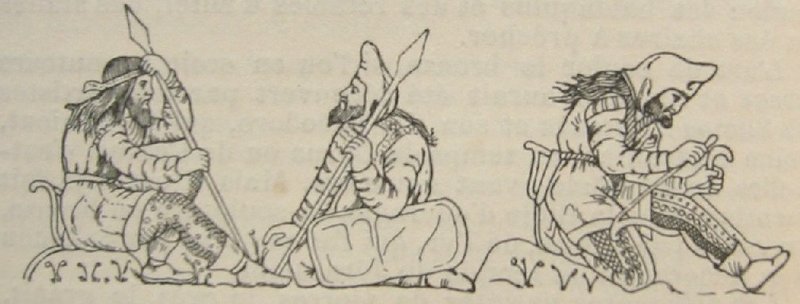
| Scythian warriors, drawn after figures on an electrum cup from the Kul''Oba kurgan burial near Kerch (Hermitage Museum, St Petersburg) |
The Scythians
Scythia was an area in Eurasia inhabited in ancient times by people probably speaking Indo-Iranian languages, known as the Scythians. The location and extent of Scythia varied over time, from the Altai region where Mongolia, China, Russia, and Kazakhstan come together to the lower Danube river area and Bulgaria. The Saka were Asian Scythians and were known as Sai to the Chinese. The Scythians first appear in Assyrian annals as Ishkuzai, who are reported as pouring in from the north some time around 700 BC, settling in Ascania and modern Azerbaijan as far as to the southeast of Lake Urmia. The most significant Scythian tribes mentioned in mainly Greek sources resided in the steppe between the Dnieper and Don rivers. The subject peoples in the periphery steppes were also commonly referred as "Scythians", but didn''t speak Iranian languages as did the Scythians proper. Priscus, the Byzantine emissary to Attila, referred to Attila''s followers repeatedly as "Scythians," so some of the Huns may have had Scythian ancestry. However, since their language, Scythian, has been shown to have strong similarities to Eastern Iranian, it is generally held that the Scythians were of Iranian origin. Etymologically, "Old Iranian Saka, Greek Scythai and Sogdian Sughde (also the very name for the Sogdians), as well as the biblical Hebrew Ashkenaz (via Syrian Askuzai) appear all to derive from skuza, an ancient Indo-European word for archer, cf. English shoot." (Torday, Mounted Archers). This ancient Indo-European word for archer in turn derives from the Proto-Indo-European root skeud, "to shoot, throw."
Scythian society
The Scythians formed a network of nomadic tribes of horse-riding conquerors. They invaded many areas in the steppes of Eurasia, including areas in present-day Kazakhstan, Azerbaijan and southern Russia. Scythian elite were buried in kurgans, high barrows heaped over chamber-tombs of larch-wood - a wood that may have had special significance as a tree of life-renewal, since it is a deciduous conifer that stands out starkly in winter against other evergreens, but returns to life every spring. Burials at Pazyryk in the Altai Mountains have included some spectacularly-preserved Scythians of the "Pazyryk culture" - including the "Ice Maiden" of the 5th century BC.
Scythian warrior-women may have inspired tales of the Amazons in Greek myth.
A Pazyryk burial found in the 1990s seems to confirm at least part of the legend. It contained the skeletons of a man and a woman, each with weapons, arrowheads, and an axe. "The woman was dressed exactly like a man. This shows that certain women, probably young and unmarried, could be warriors, literally Amazons. It didn''t offend the principles of nomadic society", according to one of the archaeologists interviewed for the 1998 NOVA documentary "The Ice Mummies".
History
To date, no certain explanation exists to account for the origin of the Scythians, nor details of how they migrated to the Caucasus or Ukraine; but the majority of scholars conjecture that they migrated westward from Central Asia between 800 BC and 600 BC.
Old records actually say that the land where the Scythians originated was called Gerrhos. They would prepare their dead and travel with them long distances to bring them for burial in Gerrhos.
Assyrian records are the first to mention the Iskuzai, from around the end of the 8th century BC. Herodotus even confirms that their king Partatua was allied with Assyria, and recognized by Mannai. In 653 BC, Partatua''s son Madius (Madyes), at the request of Ashurbanipal of Assyria, defeated the king of the Medes - Phraortes (Kshathrita), assuming control over the Medes until 625 BC. By the end of his reign, he had led the Scythians, and the Cimmerians, who seem to have been close relatives, on a pillaging spree, overrunning and plundering Assyria, Anatolia, Northern Syria, Phoenicia, Damascus and Palestine. They plundered the Temple of Venus in Ashkelon, and Jeremiah 4:7-13 mentioned them as "a destroyer of nations... [whose] chariots shall be as the whirlwind."
After 625, however, the Scythians left the Mede Empire - whether they did so voluntarily, or were expelled, is debated. At any rate, following the Mede sack of Assur in 614 BC, they were compelled to switch sides and ally themselves with the Medes. They comprised part of the force that sacked Nineveh 612 BC. Some time afterwards, the Scythians returned to the steppes.
In 512 BC, when the Scythians were attacked by king Darius the Great of Persia, they were apparently reached by crossing the Danube. Herodotus relates that, being nomads, they were able to frustrate the designs of the Persian army by letting them march through the entire country without an engagement. If he is to be believed, Darius in this manner reached as far as the Volga river.
During the 5th to 3rd centuries BC the Scythians prospered. When Herodotus wrote his Histories in the 5th century BC, Greeks distinguished a ''''Greater Scythia'''' that extended a 20-day ride from the Danube River in the west, across the steppes of today''s Ukraine to the lower Don basin, from ''''Scythia Minor''''. The Don, then known as [Tanais], has been a major trading route ever since. The Scythians apparently obtained their wealth from their control over the slave trade from the north to Greece, through the Greek Black Sea colonial ports. They also grew grain, and shipped wheat, flocks, and cheese to Greece.
The Crimean Scythians created a kingdom extending from the lower Dnieper river to the Crimea. Their capital city, Scythian Neapol, existed on the outskirts of modern day Simferopol. It was destroyed much later, in the 5th century CE, by the Goths.
In the southeasternmost corner of the plains, north of the woods of Thrace, Philip II of Macedon during the 330s settled Macedonian trading towns along routes as far north as the Danube, a river no previous Greek general had ever reached. (Fox 1973). Greek craftsmen from the colonies north of the Black Sea, made spectacular Scythian gold ornaments, applying Greek realism to depict Scythian motifs of lions, antlered reindeer and griffons. The centerpoint of Hellenic-Scythian contact was focused on the Hellenistic cities and small kingdoms of the Cimmerian Bosporus and the Crimea.
Shortly after 300 BC, the Celts seem to have displaced the Scythians from the Balkans, and in south Russia, they were gradually overwhelmed by the Sarmatians. Although the Scythians had allegedly disappeared in the 1st century BC, Eastern Romans continued to speak conventionally of "Scythians" to designate mounted Eurasian nomadic barbarians in general: in 448 CE the emissary Priscus is led to Attila''s encampment in Pannonia by two mounted "Scythians" - distinguished from the Goths and Huns who also followed Attila. Some scholars believe that the Sarmatians, the Alans, and finally the Ossetians descend from them. The latter, the only Iranian people presently resident in Europe, call their country Iron and are mostly Christians. They speak an Eastern Iranian language, Ossetic, called by them Ironig or Ironski (i.e. Iranian), that maintains some remarkable features of Gathic Avestan language. At the same time, it has a number of words remarkably similar to their modern German equivalents, such as THAU (tauen, to thaw, as snow) and GAU (district, region). Legends of the Irish and the indigenous Picts of Scotland, as well as the Hungarians, also include mention of Scythian origins.
The Scythians were not known to have had any writing system, so until recent archaeological developments, most of our information about them came from the Greeks. A treasure of gold and silver metalwork found near the town of Sakiz south of Lake Urmia, dated to between 680 and 625 BC, is apparently Scythian, and one silver dish bears some undeciphered hieroglyphs that may turn out to be a Scythian inscription.
Homer called them "the mare-milkers"; Herodotus described them in detail: their costume consisted of padded and quilted leather trousers tucked into boots, and open tunics. They rode with no stirrups or saddles, just saddlecloths. The Scythian philosopher Anacharsis visited Athens in the 6th century BC and became a legendary sage. Scythians were also known for their usage of barbed arrows, a nomadic life centered around horses -- "fed from horse-blood" according to a Roman historian -- and skill in guerilla warfare. The Scythians are thought to have been the first to tame the horse and use it in combat as well.
There is no evidence that all Scythians or Saka people spoke an Iranian language. They may have only had an Iranian speaking elite, and may or may not have been be genetically related to the original Iranians. The mother tongues of the peoples they dominated could have been Proto-Germanic, Proto-Slavic and/or even Tocharian (this might explain the presence of Tocharian in the east). (See Non-Indo-European roots of Germanic languages and Mathematical approaches to comparative linguistics (http://www.pnas.org/cgi/reprint/94/13/6585.pdf).)
• Fox, Robin Lane, 1973. Alexander the Great. ISBN 0-14-008878-4.
Archaeology and artifacts
Archaeological remains of the Scythians include elaborate tombs containing gold, silk, horses and human sacrifices. Mummification techniques and permafrost have aided in the relative preservation of some remains.
"Pazyryk culture"
One of the first Bronze Age Scythian burials documented by a modern archaeologist were the kurgans at Pazyryk, Ulagan district of the Gorno-Altai Republic, south of Novosibirsk in the Altai Mountains of southern Siberia. The name Pazyryk culture was attached to the finds: five large burial mounds and several smaller ones between 1925 and 1949, one opened in 1947 by Russian archeologist Sergei Rudenko. The burial mounds concealed chambers of larch logs covered over by large cairns of boulders and stones.
It flourished between the 7th and 3rd centuries BC in a mountain fastness known to be held by a group of Scythians that may have called themselves Sacae. It was the seat of the larger of two related Scythian groups.
All the things a person might use or need in this life were placed in the tomb as grave goods for use in the next. Among the rich or powerful, horses were sacrificed and buried with them. With the ordinary Pazyryks were only ordinary utensils, but in one was found among other treasures the famous Pazyryk Carpet, the oldest surviving wool pile oriental rug. Rudenko summed up the cultural context at one point:
All that is known to us at the present time about the culture of the population of the High Altai, who have left behind them the large cairns, permits us to refer them to the Scythian period, and the Pazyryk group in particular to the fifth century BC. This is supported by radiocarbon dating.
In the Soviet climate of ''''science'''' used as controlled propaganda, Rudenko could not stress the cultural similarities between Pazyryk and the Scythians from the Kuban and lower Dneiper Valley in European Russia. Even in modern times, the blond hair and white skin on the frozen "Ice Maiden" and other burials may be seen, but are not mentioned in the Nova segment devoted to these burials. That the ancient culture he studied was quite likely the ethnic stock ancestral to many nomadic tribes of today, including modern Altaians, Kirgiz, and Kazakhs, has become a source of considerable pride today for the Gorno-Altai Republic.
Scythian Gelonus (Belsk)
Recent digs in Belsk, Ukraine uncovered a vast city believed to be the Scythian capital Gelonus described by Herodotus. The city''''s commanding ramparts and vast 40 square kilometers exceeded even the outlandish size reported by Herodotus. Its location at the northern edge of Ukraine''s steppe would have allowed strategic control of the north-south trade route. Judging by the finds dated to the 5th and 4th centuries BC, craft workshops and Greek pottery abounded, and perhaps, slaves destined for Greece.
The Ryzhanovka kurgan
A kurgan or burial mound near the village of Ryzhanovka in Ukraine, 75 miles south of Kyiv, has revealed one of the few unlooted tombs of a Scythian chieftain, one who was ruling in the forest-steppe area on the western fringe of Scythian lands. There, at a date late in Scythian culture (ca. 250 - 225 BC), a recently nomadic aristocracy was gradually adopting the agricultural lifestyle of their subjects: the tomb contained a mock hearth, the first ever found in a Scythian context, symbolic of the warmth and comfort of a farmhouse. |
http://historyalans.narod.ru/scytians.html - http://historyalans.narod.ru/scytians.html
------------- What a handsome figure of a dragon. No wonder I fall madly in love with the Alani Dragon now, the avatar, it's a gorgeous dragon picture.
|
Replies:
Posted By: Nick1986
Date Posted: 28-Jan-2012 at 19:52
I'd like to hear more about Scythian culture. Is there any evidence they drank out of human skulls and sewed the scalps of dead enemies to their cloaks, as Herodotus claimed?
http://www.youtube.com/watch?v=TV5ztdWx56I - Herodotus on the Scythians
-------------
Me Grimlock not nice Dino! Me bash brains!
|
Posted By: TheAlaniDragonRising
Date Posted: 28-Jan-2012 at 20:04
Originally posted by Nick1986
I'd like to hear more about Scythian culture. Is there any evidence they drank out of human skulls and sewed the scalps of dead enemies to their cloaks, as Herodotus claimed?
http://www.youtube.com/watch?v=TV5ztdWx56I - Herodotus on the Scythians
|
I have found a little something so far suggesting the use of human skulls when it comes to Scythian drinking vessels.
http://books.google.co.uk/books?id=ijJ4o2iorhkC&lpg=PA81&ots=Pg4Di1Opqm&dq=human%20skull%20drinking%20vessels%20of%20the%20scythians%20found&pg=PA81#v=onepage&q=human%20skull%20drinking%20vessels%20of%20the%20scythians%20found&f=false - http://books.google.co.uk/books?id=ijJ4o2iorhkC&lpg=PA81&ots=Pg4Di1Opqm&dq=human%20skull%20drinking%20vessels%20of%20the%20scythians%20found&pg=PA81#v=onepage&q=human%20skull%20drinking%20vessels%20of%20the%20scythians%20found&f=false
-------------
What a handsome figure of a dragon. No wonder I fall madly in love with the Alani Dragon now, the avatar, it's a gorgeous dragon picture.
|
Posted By: TheAlaniDragonRising
Date Posted: 29-Jan-2012 at 09:27
|
In the OP there's something about a Scythian philosopher called Anacharsis, who visited Athens in the 6th century BC, and who became a legendary sage. I thought this was very interesting, and even more so when finding out that his philosophical approach was very much that of a cynic, and much earlier than the Greek movement known as cynicism as we know it now. He is considered as a forerunner to that movement, but I would say that we could surmise that without his input, Greek philosophy would not have become the influential force it turned into, and the development of the modern world as we know it would have been almost impossible. This is what I have found.
| Anacharsis ( http://en.wikipedia.org/wiki/Greek_language - Greek : Ἀνάχαρσις) was a http://en.wikipedia.org/wiki/Scythian - Scythian philosopher who travelled from his homeland on the northern shores of the http://en.wikipedia.org/wiki/Black_Sea - Black Sea to Athens in the early 6th century BCE and made a great impression as a forthright, outspoken " http://en.wikipedia.org/wiki/Barbarian - barbarian ", apparently a forerunner of the http://en.wikipedia.org/wiki/Cynics - Cynics , though none of his works have survived. Anacharsis the son of Gnurus, a Scythian chief, was half Greek and from a mixed Hellenistic culture, apparently in the region of the http://en.wikipedia.org/wiki/Cimmerian_Bosporus - Cimmerian Bosporus . He left his native country to travel in pursuit of knowledge, and came to http://en.wikipedia.org/wiki/Athens - Athens about 589 BCE,at a time when http://en.wikipedia.org/wiki/Solon - Solon was occupied with his legislative measures. According to the story recounted by http://en.wikipedia.org/wiki/Hermippus_of_Smyrna - Hermippus , he arrived at the house of Solon and said, "I have traveled here from afar to make you my friend." Solon replied, "It's better to make friends at home." Thereupon the Scythian replied, "Then it is necessary for you, being at home, to make friends with me." Solon laughed and accepted him as his friend. He cultivated the outsider's knack of seeing the illogic in familiar things. For example, Plutarch remarks that he "expressed his wonder at the fact that in Greece wise men spoke and fools decided." His conversation was droll and frank, and Solon and the Athenians took to him as a sage and philosopher. His rough and free discourse became proverbial among Athenians as 'Scythian discourse'. Anacharsis was the first foreigner ( http://en.wikipedia.org/wiki/Metic - metic ) who received the privileges of Athenian citizenship. He was reckoned by some ancient authors as one of the http://en.wikipedia.org/wiki/Seven_Sages_of_Greece - Seven Sages of Greece , and it is said that he was initiated into the http://en.wikipedia.org/wiki/Eleusinian_Mysteries - Eleusinian Mysteries of the Great Goddess, a privilege denied to those who did not speak fluent Greek. According to http://en.wikipedia.org/wiki/Herodotus - Herodotus , when Anacharsis returned to the Scythians he was killed by his own brother for his Greek ways and especially for the impious attempt to sacrifice to the Mother Goddess http://en.wikipedia.org/wiki/Cybele - Cybele , whose cult was unwelcome among the Scythians. None of the works ascribed to him in http://en.wikipedia.org/wiki/Ancient_history - ancient times , if indeed they were written by him, have survived. He was said to have written a book comparing the laws of the Scythians with the laws of the Greeks, as well as work on the art of war. All that remains of his thought is what later tradition ascribes to him. He became famous for the simplicity of his way of living and his acute observations on the institutions and customs of the Greeks. He exhorted moderation in everything, saying that the vine bears three clusters of grapes: the first wine, pleasure; the second, drunkenness; the third, disgust. So he became a kind of http://en.wikipedia.org/wiki/Emblem - emblem to the Athenians, who inscribed on his statues: 'Restrain your tongues, your appetites, your passions.' There are ten extant letters ascribed to him, one of which is also quoted by http://en.wikipedia.org/wiki/Cicero - Cicero : Greetings from Anacharsis to Hanno: My clothing is a Scythian cloak, my shoes are the hard soles of my feet, my bed is the earth, my food is only seasoned by hunger - and I eat nothing but milk and cheese and meat. Come and visit me, and you will find me at peace. You want to give me something. But give it to your fellow-citizens instead, or let the immortal gods have it.
All of the letters are spurious. The first nine probably date from the 3rd century BCE, they are usually included among the http://en.wikipedia.org/wiki/Cynic_epistles - Cynic epistles , and reflect how the Cynic philosophers viewed him as prefiguring many of their ideas; the tenth letter is quoted by http://en.wikipedia.org/wiki/Diogenes_Laertius - Diogenes Laertius , it is addressed to http://en.wikipedia.org/wiki/Croesus - Croesus , the proverbially rich king of http://en.wikipedia.org/wiki/Lydia - Lydia , it too is fictitious: Anacharsis to Croesus: O king of the Lydians, I am come to the country of the Greeks, in order to become acquainted with their customs and institutions; but I have no need of gold, and shall be quite contented if I return to Scythia a better man than I left it. However I will come to Sardis, as I think it very desirable to become a friend of yours.
http://en.wikipedia.org/wiki/Strabo - Strabo makes him the (probably legendary) inventor of the http://en.wikipedia.org/wiki/Anchor - anchor with two flukes, and others made him the inventor of the http://en.wikipedia.org/wiki/Potters_wheel - potter's wheel . Having been informed that http://en.wikipedia.org/wiki/Solon - Solon was employed to draw up a code of laws for the http://en.wikipedia.org/wiki/Athenians - Athenians , Anacharsis described his occupation, saying: - "Laws are spider-webs, which catch the little flies, but cannot hold the big ones."
|
http://en.wikipedia.org/wiki/Anacharsis - http://en.wikipedia.org/wiki/Anacharsis
------------- What a handsome figure of a dragon. No wonder I fall madly in love with the Alani Dragon now, the avatar, it's a gorgeous dragon picture.
|
Posted By: TheAlaniDragonRising
Date Posted: 29-Jan-2012 at 15:30
|
These are examples of Scythian art.
-------------
What a handsome figure of a dragon. No wonder I fall madly in love with the Alani Dragon now, the avatar, it's a gorgeous dragon picture.
|
Posted By: Ollios
Date Posted: 30-Jan-2012 at 01:31
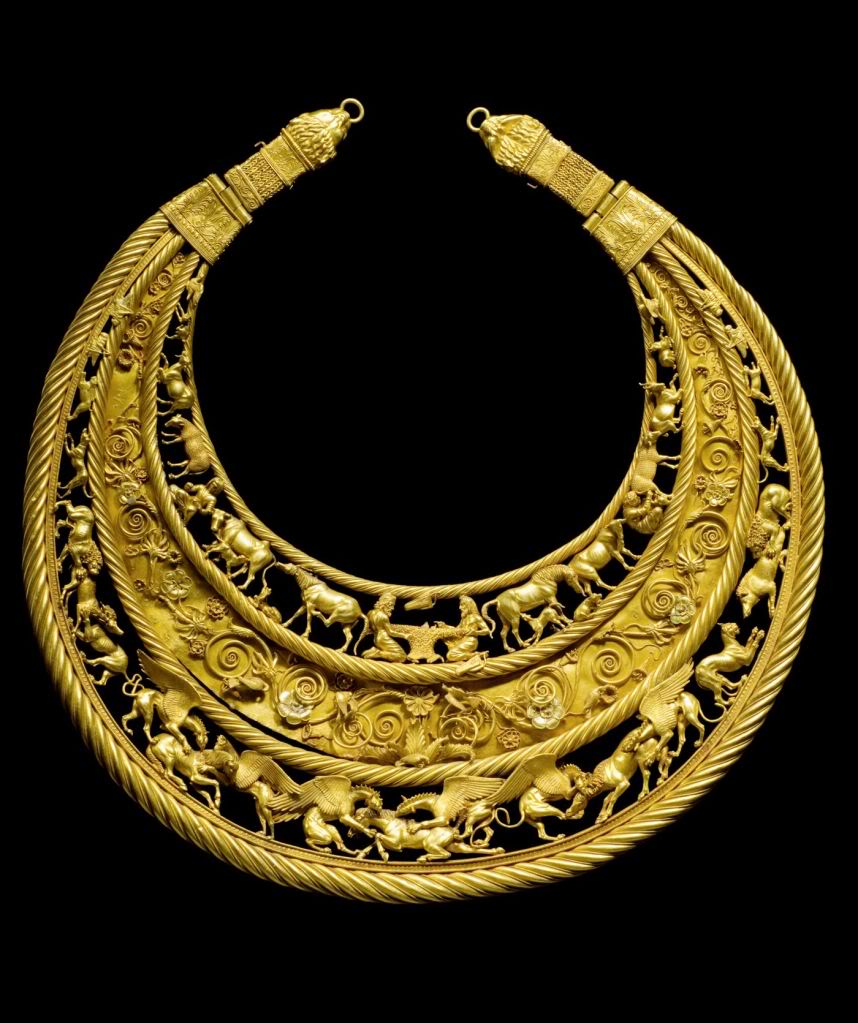
I was admired this necklace when I saw it in Junior Larousse
-------------
Ellerin Kabe'si var,
Benim Kabem İnsandır
|
Posted By: TheAlaniDragonRising
Date Posted: 30-Jan-2012 at 16:06
Originally posted by Ollios

I was admired this necklace when I saw it in Junior Larousse
|
Yes, Ollios, it is beautiful, and I think I've seen a similar one from the Crimea somewhere, which I will have to look for, unless someone else finds it and posts it first.
-------------
What a handsome figure of a dragon. No wonder I fall madly in love with the Alani Dragon now, the avatar, it's a gorgeous dragon picture.
|
Posted By: TheAlaniDragonRising
Date Posted: 30-Jan-2012 at 16:08
treasure of scythians
http://94.199.48.32/scythians/k1.html"> k1.jpg
95.45 KB | http://94.199.48.32/scythians/k10.html"> k10.jpg
249.68 KB | http://94.199.48.32/scythians/k100.html"> k100.jpg
186.59 KB | http://94.199.48.32/scythians/k101.html"> k101.jpg
137.00 KB | http://94.199.48.32/scythians/k102.html"> k102.jpg
183.52 KB | http://94.199.48.32/scythians/k103.html"> k103.jpg
166.76 KB | http://94.199.48.32/scythians/k103_1.html"> k103_1.jpg
273.12 KB | http://94.199.48.32/scythians/k104.html"> k104.jpg
205.58 KB | http://94.199.48.32/scythians/k105.html"> k105.jpg
194.60 KB | http://94.199.48.32/scythians/k106.html"> k106.jpg
225.40 KB | http://94.199.48.32/scythians/k107.html"> k107.jpg
135.95 KB | http://94.199.48.32/scythians/k108.html"> k108.jpg
178.72 KB | http://94.199.48.32/scythians/k109.html"> k109.jpg
187.17 KB | http://94.199.48.32/scythians/k11.html"> k11.jpg
153.04 KB | http://94.199.48.32/scythians/k110.html"> k110.jpg
145.82 KB | http://94.199.48.32/scythians/k12.html"> k12.jpg
199.65 KB | http://94.199.48.32/scythians/k13.html"> k13.jpg
172.20 KB | http://94.199.48.32/scythians/k14.html"> k14.jpg
155.24 KB | http://94.199.48.32/scythians/k15.html"> k15.jpg
173.33 KB | http://94.199.48.32/scythians/k16.html"> k16.jpg
201.45 KB | http://94.199.48.32/scythians/k17.html"> k17.jpg
185.99 KB | http://94.199.48.32/scythians/k18.html"> k18.jpg
181.55 KB | http://94.199.48.32/scythians/k19.html"> k19.jpg
200.87 KB | http://94.199.48.32/scythians/k2.html"> k2.jpg
227.10 KB | http://94.199.48.32/scythians/k20.html"> k20.jpg
150.63 KB | http://94.199.48.32/scythians/k21.html"> k21.jpg
171.41 KB | http://94.199.48.32/scythians/k22.html"> k22.jpg
166.27 KB | http://94.199.48.32/scythians/k23.html"> k23.jpg
140.57 KB | http://94.199.48.32/scythians/k24.html"> k24.jpg
172.10 KB | http://94.199.48.32/scythians/k25.html"> k25.jpg
249.78 KB | http://94.199.48.32/scythians/k26.html"> k26.jpg
217.71 KB | http://94.199.48.32/scythians/k27.html"> k27.jpg
224.76 KB | http://94.199.48.32/scythians/k28.html"> k28.jpg
181.19 KB | http://94.199.48.32/scythians/k29.html"> k29.jpg
195.60 KB | http://94.199.48.32/scythians/k3.html"> k3.jpg
158.70 KB | http://94.199.48.32/scythians/k30.html"> k30.jpg
151.10 KB | http://94.199.48.32/scythians/k31.html"> k31.jpg
177.13 KB | http://94.199.48.32/scythians/k32.html"> k32.jpg
202.61 KB | http://94.199.48.32/scythians/k33.html"> k33.jpg
191.38 KB | http://94.199.48.32/scythians/k34.html"> k34.jpg
130.05 KB | http://94.199.48.32/scythians/k35.html"> k35.jpg
133.06 KB | http://94.199.48.32/scythians/k36.html"> k36.jpg
175.85 KB | http://94.199.48.32/scythians/k37.html"> k37.jpg
152.77 KB | http://94.199.48.32/scythians/k38.html"> k38.jpg
196.82 KB | http://94.199.48.32/scythians/k39.html"> k39.jpg
126.07 KB | http://94.199.48.32/scythians/k4.html"> k4.jpg
154.93 KB | http://94.199.48.32/scythians/k40.html"> k40.jpg
135.21 KB | http://94.199.48.32/scythians/k41.html"> k41.jpg
148.16 KB | http://94.199.48.32/scythians/k42.html"> k42.jpg
143.20 KB | http://94.199.48.32/scythians/k43.html"> k43.jpg
178.49 KB | http://94.199.48.32/scythians/k44.html"> k44.jpg
262.06 KB | http://94.199.48.32/scythians/k45.html"> k45.jpg
173.96 KB | http://94.199.48.32/scythians/k47.html"> k47.jpg
214.65 KB | http://94.199.48.32/scythians/k48.html"> k48.jpg
165.30 KB | http://94.199.48.32/scythians/k49.html"> k49.jpg
196.63 KB | http://94.199.48.32/scythians/k5.html"> k5.jpg
179.38 KB | http://94.199.48.32/scythians/k50.html"> k50.jpg
187.86 KB | http://94.199.48.32/scythians/k51.html"> k51.jpg
130.45 KB | http://94.199.48.32/scythians/k52.html"> k52.jpg
228.10 KB | http://94.199.48.32/scythians/k53.html"> k53.jpg
195.73 KB | http://94.199.48.32/scythians/k54.html"> k54.jpg
180.38 KB | http://94.199.48.32/scythians/k55.html"> k55.jpg
139.88 KB | http://94.199.48.32/scythians/k56.html"> k56.jpg
128.62 KB | http://94.199.48.32/scythians/k57.html"> k57.jpg
129.54 KB | http://94.199.48.32/scythians/k58.html"> k58.jpg
276.60 KB | http://94.199.48.32/scythians/k59.html"> k59.jpg
196.17 KB | http://94.199.48.32/scythians/k6.html"> k6.jpg
210.91 KB | http://94.199.48.32/scythians/k60.html"> k60.jpg
400.95 KB | http://94.199.48.32/scythians/k61.html"> k61.jpg
244.44 KB | http://94.199.48.32/scythians/k62.html"> k62.jpg
205.59 KB | http://94.199.48.32/scythians/k63.html"> k63.jpg
203.37 KB | http://94.199.48.32/scythians/k64.html"> k64.jpg
168.93 KB | http://94.199.48.32/scythians/k65.html"> k65.jpg
182.32 KB | http://94.199.48.32/scythians/k66.html"> k66.jpg
160.11 KB | http://94.199.48.32/scythians/k67.html"> k67.jpg
224.06 KB | http://94.199.48.32/scythians/k68.html"> k68.jpg
189.51 KB | http://94.199.48.32/scythians/k69.html"> k69.jpg
191.89 KB | http://94.199.48.32/scythians/k7.html"> k7.jpg
187.04 KB | http://94.199.48.32/scythians/k70.html"> k70.jpg
188.99 KB | http://94.199.48.32/scythians/k71.html"> k71.jpg
196.32 KB | http://94.199.48.32/scythians/k72.html"> k72.jpg
178.11 KB | http://94.199.48.32/scythians/k73.html"> k73.jpg
169.78 KB | http://94.199.48.32/scythians/k74.html"> k74.jpg
193.44 KB | http://94.199.48.32/scythians/k75.html"> k75.jpg
152.83 KB | http://94.199.48.32/scythians/k76.html"> k76.jpg
197.32 KB | http://94.199.48.32/scythians/k77.html"> k77.jpg
208.96 KB | http://94.199.48.32/scythians/k78.html"> k78.jpg
192.24 KB | http://94.199.48.32/scythians/k79.html"> k79.jpg
188.91 KB | http://94.199.48.32/scythians/k8.html"> k8.jpg
178.25 KB | http://94.199.48.32/scythians/k80.html"> k80.jpg
190.85 KB | http://94.199.48.32/scythians/k81.html"> k81.jpg
224.24 KB | http://94.199.48.32/scythians/k82.html"> k82.jpg
231.47 KB | http://94.199.48.32/scythians/k83.html"> k83.jpg
148.29 KB | http://94.199.48.32/scythians/k84.html"> k84.jpg
156.88 KB | http://94.199.48.32/scythians/k85.html"> k85.jpg
168.22 KB | http://94.199.48.32/scythians/k86.html"> k86.jpg
194.83 KB | http://94.199.48.32/scythians/k87.html"> k87.jpg
184.43 KB | http://94.199.48.32/scythians/k88.html"> k88.jpg
230.88 KB | http://94.199.48.32/scythians/k89.html"> k89.jpg
187.80 KB | http://94.199.48.32/scythians/k9.html"> k9.jpg
200.78 KB | http://94.199.48.32/scythians/k90.html"> k90.jpg
282.67 KB | http://94.199.48.32/scythians/k91.html"> k91.jpg
319.21 KB | http://94.199.48.32/scythians/k92.html"> k92.jpg
187.56 KB | http://94.199.48.32/scythians/k93.html"> k93.jpg
122.88 KB | http://94.199.48.32/scythians/k94.html"> k94.jpg
142.90 KB | http://94.199.48.32/scythians/k95.html"> k95.jpg
175.14 KB | http://94.199.48.32/scythians/k96.html"> k96.jpg
223.80 KB | http://94.199.48.32/scythians/k97.html"> k97.jpg
151.85 KB | http://94.199.48.32/scythians/k98.html"> k98.jpg
158.74 KB | http://94.199.48.32/scythians/k99.html"> k99.jpg
162.46 KB | http://94.199.48.32/scythians/kh1.html"> kh1.jpg
321.24 KB | http://94.199.48.32/scythians/kh2.html"> kh2.jpg
268.93 KB |
|
-------------
What a handsome figure of a dragon. No wonder I fall madly in love with the Alani Dragon now, the avatar, it's a gorgeous dragon picture.
|
Posted By: Nick1986
Date Posted: 30-Jan-2012 at 19:25
Impressive. Their metalworking skills rival those of more advanced societies
-------------
Me Grimlock not nice Dino! Me bash brains!
|
Posted By: TheAlaniDragonRising
Date Posted: 31-Jan-2012 at 16:06
| Marijuana The Scythians were fond of marijuana and were responsible for bringing it from Central Asia to Egypt and Eastern Europe. In one Scythian grave, archaeologists found a skull with three small holes drilled into it – probably to ease swelling. Beside the skull, the archaeologists found a cache of marijuana, ostensibly to relieve the man’s headache in the next life. From Herodotus comes what is, in all likelihood, the most ancient description of hotboxing: “After the burial . . . they set up three poles leaning together to a point and cover them with woolen mats . . . They make a pit in the centre beneath the poles and throw red-hot stones into it . . . they take the seed of the hemp and creeping under the mats they throw it on the red-hot stones, and being thrown, it smolders and sends forth so much steam that no Greek vapour-bath could surpass it. The Scythians howl in their joy at the vapour-bath.” |
http://listverse.com/2010/01/05/top-10-interesting-facts-about-the-scythians/ - http://listverse.com/2010/01/05/top-10-interesting-facts-about-the-scythians/
-------------
What a handsome figure of a dragon. No wonder I fall madly in love with the Alani Dragon now, the avatar, it's a gorgeous dragon picture.
|
Posted By: Nick1986
Date Posted: 31-Jan-2012 at 19:10
Slightly different to the way i'm accustomed to. I'd imagine it would be stronger if they burned larger quantities of weed on a fire
-------------
Me Grimlock not nice Dino! Me bash brains!
|
Posted By: PanzerOberst
Date Posted: 02-Feb-2012 at 02:45
Thanks Alani Dragon, they're a very nice collection.
-------------
"If the tanks succeed, then victory follows"
- Heinz W. Guderian
|
Posted By: Nick1986
Date Posted: 02-Feb-2012 at 19:07
Originally posted by TheAlaniDragonRising
Originally posted by Nick1986
I'd like to hear more about Scythian culture. Is there any evidence they drank out of human skulls and sewed the scalps of dead enemies to their cloaks, as Herodotus claimed?
http://www.youtube.com/watch?v=TV5ztdWx56I - Herodotus on the Scythians
|
I have found a little something so far suggesting the use of human skulls when it comes to Scythian drinking vessels.
http://books.google.co.uk/books?id=ijJ4o2iorhkC&lpg=PA81&ots=Pg4Di1Opqm&dq=human%20skull%20drinking%20vessels%20of%20the%20scythians%20found&pg=PA81#v=onepage&q=human%20skull%20drinking%20vessels%20of%20the%20scythians%20found&f=false - http://books.google.co.uk/books?id=ijJ4o2iorhkC&lpg=PA81&ots=Pg4Di1Opqm&dq=human%20skull%20drinking%20vessels%20of%20the%20scythians%20found&pg=PA81#v=onepage&q=human%20skull%20drinking%20vessels%20of%20the%20scythians%20found&f=false
|
I wonder if there's a connection to the Celts and Vikings who did the same thing? There was even a Muslim ruler who drank from the skull of a Crusader leader
-------------
Me Grimlock not nice Dino! Me bash brains!
|
Posted By: TheAlaniDragonRising
Date Posted: 02-Feb-2012 at 20:24
Celts and Scythians Linked by Archaeological DiscoveriesThe archaeological evidence shows that the Celts and Scyths both freely shared and mingled. The Celtic Hallstatt culture and the Scythian Vekerzug or Thracian culture are excellent examples that show how closely these two peoples interacted with one another. Historians and archaeologists label the people who established the Hallstatt Culture (700-450 B.C.) as either proto-Celts or just plain Celts. The culture, as represented by the grave goods of the Hallstatt aristocracy, is remarkably universal and distinct. The Hallstatt Celts were innovative metal workers. Their iron weapons provided them with a distinct military advantage. Like the Scythians, they also brought with them an improved breed of horses that could run faster with great stamina in comparison to the horses already in northern-central Europe, giving them greater mobility. Many of the richest Hallstatt burial places contain sturdy four-wheeled wagons that show a significant technical competency. Their spoke wheels were fitted with iron tires shrunken and nailed around the composite wooden rims. Their wooden yokes were decorated by patterns of bronze nail heads. These artifact-rich sites seem to have been initially concentrated from the area of the Upper Danube to Bohemia. Later in the 500s B.C., however, the Celts' Hallstatt cultural zone of control expanded to the west. Significantly, vehicle burials were also a distinctive trademark of the Scythian culture. The late eighth and seventh centuries B.C. were a time of disruption and change not only at the headwaters of the Danube, but also in the Black Sea and Caucasus regions, where there were migrating tribes of Scythians. The Hallstatt Celts' lifestyle had many similarities to that of the Scythians. A Hallstatt sword in Vienna's Natur-Historisches Museum has ornamentation that shows a Celt wearing profusely decorated trousers. This is comparable to the Scythian dress as pictured on the Chertomlyk vase (from the Black Sea area). This Vienna sword also depicts a tailcoat strikingly similar to Eastern Scythian apparel found by Russian archaeologists at Katanda in the southern Altai (Siberia). Another Celtic sword found at Port Bern, Switzerland, was stamped during its manufacture with a decoration of two standing horned animals flanking a tree of life—a classic Near Eastern, Scythian theme. The archaeological evidence shows that the Celts and Scyths both freely shared and mingled. Russian and Eastern European excavations plainly reveal the blending of these two groups. Most scholars also agree that it is evident that the Scythians of Eastern Europe maintained close relations with the Scythians still on the steppes in the east and the Hallstatt–La Tène Celts in the west. |
-------------
What a handsome figure of a dragon. No wonder I fall madly in love with the Alani Dragon now, the avatar, it's a gorgeous dragon picture.
|
Posted By: TheAlaniDragonRising
Date Posted: 04-Feb-2012 at 10:05
Posted By: TheAlaniDragonRising
Date Posted: 21-Feb-2012 at 06:19
|
Scythian religion refers to the mythology, ritual practices and beliefs of the http://en.wikipedia.org/wiki/Scythians - Scythians , an ancient http://en.wikipedia.org/wiki/Iranians - Iranian people who dominated the http://en.wikipedia.org/wiki/Pontic-Caspian_steppe - Pontic-Caspian steppe throughout http://en.wikipedia.org/wiki/Classical_Antiquity - Classical Antiquity . What little is known of the religion is drawn from the work of the 5th century Greek historian and ethnographer http://en.wikipedia.org/wiki/Herodotus - Herodotus . It is assumed to have been related to the earlier http://en.wikipedia.org/wiki/Proto-Indo-Iranian_religion - Proto-Indo-Iranian religion , and to have influenced later http://en.wikipedia.org/wiki/Slavic_mythology - Slavic , Hungarian and http://en.wikipedia.org/wiki/Turkic_mythology - Turkic mythologies, as well as http://en.wikipedia.org/wiki/Ossetian_mythology - Ossetian traditions which are believed to have descended from Scythian mythology.
Archaeological contextThe primary archaeological context of http://en.wikipedia.org/wiki/Horse_sacrifice - horse sacrifice are burials, notably http://en.wikipedia.org/wiki/Chariot_burial - chariot burials , but graves with horse remains reach from the http://en.wikipedia.org/wiki/Eneolithic - Eneolithic well into historical times. http://en.wikipedia.org/wiki/Herodotus - Herodotus describes the execution of horses at the burial of a http://en.wikipedia.org/wiki/Scythian - Scythian king, and Iron Age http://en.wikipedia.org/wiki/Kurgan - kurgan graves known to contain horses number in the hundreds. The http://en.wikipedia.org/wiki/Scythian - Scythians had some reverence for the stag, which is one of the most common motifs in their artwork, especially at funeral sites. The swift animal was believed to speed the spirits of the dead on their way, which perhaps explains the curious antlered headdresses found on horses buried at http://en.wikipedia.org/wiki/Pazyryk - Pazyryk .
PantheonAccording to http://en.wikipedia.org/wiki/Herodotus - Herodotus , the Scythians worshipped a pantheon of seven gods and goddesses (heptad), which he equates with http://en.wikipedia.org/wiki/Greek_mythology - Greek divinities of Classical Antiquity following the http://en.wikipedia.org/wiki/Interpretatio_graeca - interpretatio graeca . He mentions eight deities in particular, the eighth being worshipped by the Royal Scythians, and gives the http://en.wikipedia.org/wiki/Scythian_languages - Scythian names for six of them as follows: - Tabiti - http://en.wikipedia.org/wiki/Hestia - Hestia
- Papaios - http://en.wikipedia.org/wiki/Zeus - Zeus
- Api - http://en.wikipedia.org/wiki/Gaia_%28mythology%29 - Gaia
- Oitosyros - http://en.wikipedia.org/wiki/Apollo - Apollo
- Argimpasa - http://en.wikipedia.org/wiki/Aphrodite_Urania - Aphrodite Urania
- Thagimasidas - http://en.wikipedia.org/wiki/Poseidon - Poseidon
To these, Herodotus adds http://en.wikipedia.org/wiki/Heracles - Heracles and http://en.wikipedia.org/wiki/Ares - Ares , a god of war (see below).
Sacrifice
The mode of Scythian sacrifice was, in the opinion of Herodotus, relatively simple. Sacrificial victims included various kinds of livestock, though the most prestigious offering was considered to be the horse. The pig, on the other hand, was never offered in sacrifice, and apparently the Scythians were loath to keep swine within their lands. Herodotus describes the Scythian manner of sacrifice as follows: The victim stands with its fore-feet tied, and the sacrificing priest stands behind the victim, and by pulling the end of the cord he throws the beast down; and as the victim falls, he calls upon the god to whom he is sacrificing, and then at once throws a noose round its neck, and putting a small stick into it he turns it round and so strangles the animal, without either lighting a fire or making any first offering from the victim or pouring any libation over it: and when he has strangled it and flayed off the skin, he proceeds to boil it. [...] Then when the flesh is boiled, the sacrificer takes a first offering of the flesh and of the vital organs and casts it in front of him.
Worship of "Ares"
Although Tabiti was apparently the most important deity in the Scythian pantheon, the worship accorded to the deity Herodotus refers to as "Ares" was unique. He notes that "it is not their custom [...] to make images, altars or temples to any except Ares, but to him it is their custom to make them". He describes the construction of the altar and the subsequent sacrifice as follows: In each district of the several governments they have a temple of Ares set up in this way: bundles of brushwood are heaped up for about three furlongs in length and in breadth, but less in height; and on the top of this there is a level square made, and three of the sides rise sheer but by the remaining one side the pile may be ascended. Every year they pile on a hundred and fifty wagon-loads of brushwood, for it is constantly settling down by reason of the weather. Upon this pile of which I speak each people has an ancient iron sword set up, and this is the sacred symbol of Ares. To this sword they bring yearly offerings of cattle and of horses; and they have the following sacrifice in addition, beyond what they make to the other gods, that is to say, of all the enemies whom they take captive in war they sacrifice one man in every hundred, not in the same manner as they sacrifice cattle, but in a different manner: for they first pour wine over their heads, and after that they cut the throats of the men, so that the blood runs into a bowl; and then they carry this up to the top of the pile of brushwood and pour the blood over the sword. This, I say, they carry up; and meanwhile below by the side of the temple they are doing thus: they cut off all the right arms of the slaughtered men with the hands and throw them up into the air, and then when they have finished offering the other victims, they go away; and the arm lies wheresoever it has chanced to fall, and the corpse apart from it.
According to http://en.wikipedia.org/wiki/Tadeusz_Sulimirski - Tadeusz Sulimirski , this form of worship continued among the descendants of the Scythians, the http://en.wikipedia.org/wiki/Alans - Alans , through to the 4th century CE.
Enarei
The Enarei were a privileged caste of hereditary priests which played an important political role in Scythian society as they were believed to have received the gift of prophesy directly from the goddess Argimpasa. The method employed by the Enarei differed from that practised by traditional Scythian diviners: whereas the latter used a bundle of willow rods, the Enarei used strips cut from the bark of the linden tree (genus http://en.wikipedia.org/wiki/Tilia - tilia ) to tell the future. The Enarei were also noted for dressing themselves in the clothes of women, a custom which Herodotus understands as being reflected in the title ena-rei, glossing this as ἀνδρό-γυνοι or "man-women".
|
http://en.wikipedia.org/wiki/Scythian_religion - http://en.wikipedia.org/wiki/Scythian_religion
-------------
What a handsome figure of a dragon. No wonder I fall madly in love with the Alani Dragon now, the avatar, it's a gorgeous dragon picture.
|
Posted By: Crixus
Date Posted: 03-Mar-2012 at 00:01
Originally posted by TheAlaniDragonRising
Celts and Scythians Linked by Archaeological DiscoveriesThe archaeological evidence shows that the Celts and Scyths both freely shared and mingled. The Celtic Hallstatt culture and the Scythian Vekerzug or Thracian culture are excellent examples that show how closely these two peoples interacted with one another. Historians and archaeologists label the people who established the Hallstatt Culture (700-450 B.C.) as either proto-Celts or just plain Celts. The culture, as represented by the grave goods of the Hallstatt aristocracy, is remarkably universal and distinct. The Hallstatt Celts were innovative metal workers. Their iron weapons provided them with a distinct military advantage. Like the Scythians, they also brought with them an improved breed of horses that could run faster with great stamina in comparison to the horses already in northern-central Europe, giving them greater mobility. Many of the richest Hallstatt burial places contain sturdy four-wheeled wagons that show a significant technical competency. Their spoke wheels were fitted with iron tires shrunken and nailed around the composite wooden rims. Their wooden yokes were decorated by patterns of bronze nail heads. These artifact-rich sites seem to have been initially concentrated from the area of the Upper Danube to Bohemia. Later in the 500s B.C., however, the Celts' Hallstatt cultural zone of control expanded to the west. Significantly, vehicle burials were also a distinctive trademark of the Scythian culture. The late eighth and seventh centuries B.C. were a time of disruption and change not only at the headwaters of the Danube, but also in the Black Sea and Caucasus regions, where there were migrating tribes of Scythians. The Hallstatt Celts' lifestyle had many similarities to that of the Scythians. A Hallstatt sword in Vienna's Natur-Historisches Museum has ornamentation that shows a Celt wearing profusely decorated trousers. This is comparable to the Scythian dress as pictured on the Chertomlyk vase (from the Black Sea area). This Vienna sword also depicts a tailcoat strikingly similar to Eastern Scythian apparel found by Russian archaeologists at Katanda in the southern Altai (Siberia). Another Celtic sword found at Port Bern, Switzerland, was stamped during its manufacture with a decoration of two standing horned animals flanking a tree of life—a classic Near Eastern, Scythian theme. The archaeological evidence shows that the Celts and Scyths both freely shared and mingled. Russian and Eastern European excavations plainly reveal the blending of these two groups. Most scholars also agree that it is evident that the Scythians of Eastern Europe maintained close relations with the Scythians still on the steppes in the east and the Hallstatt–La Tène Celts in the west. |
|
I find this interesting. I have heard and
read that Celts and Germanics either came from or were related to Scythians
|
Posted By: mojobadshah
Date Posted: 12-Mar-2012 at 22:19
|
I find the Celtic-Scythian connection very intriguing. The earliest Irish literature, itself, such as the "The Lebor Gabala Ern" accounts for all three migrations in the Ireland, Fir Bolg, Tuatha DeDanaan, and the Sons of Mil, having come out of Scythia. More recently Celtic historians have tried to elaborate on these Irish-Iranian connections. The name Eremon (the son of Mil), and Aryaman (an Celtic deity) are akin to the name of the Zoroastrian deity Airyaman. I've also come across links between the name of the Zoroastrian God, Hormazd (Ahura Mazda) and the Irish solar deity Crom. But another etymology connects Crom, also known as Crom Cruach to a Persian deity known as Karam Kerugher. I take it that Karam means "warmth" and Kerugher (could be a mispronouncing of Kerudeghar) means "God." But I can't seem to find any evidence of a Persian deity named Karam Kerugher. Is the name rooted in Zoroastrian belief system? Is this a synonym for God in Persian? Or are these scholars just making it up?
|
Posted By: electrondady1
Date Posted: 19-Mar-2014 at 11:18
a fascinating culture . i'm coming to the Scythians though a search for Celtic origins.
everything points to a common heritage.
my research shows the Celts moving up the Danube and the Scythians, moving up the Dniester after the black sea inundation.
some say , around 5600BC.
that puts it just about the same time as the domestication of the horse.
i suppport the kurgan hypothesis.
|
Posted By: opuslola
Date Posted: 19-Mar-2014 at 22:58
Originally posted by TheAlaniDragonRising
I thought I would start a thread to discuss what is known about the Scythians, or at least in some cases what we think we know about the Scythians. Hopefully then this thread then can develop into other areas connecting the Scythians for other threads later.I will start off with something I have just found on one site for you to read through and comment on. Feel free to write and post other material relevant to this subject. 
| <b style="font-family: 'Times New Roman'; font-size: 19px; line-height: normal; ">Scythian warriors, drawn after figures on an electrum cup from the Kul''Oba kurgan burial near Kerch (Hermitage Museum, <b style="font-family: 'Times New Roman'; font-size: 19px; line-height: normal; ">St Petersburg) |
<b style="font-family: 'Times New Roman'; font-size: 19px; line-height: normal; "> <b style="font-family: 'Times New Roman'; font-size: 19px; line-height: normal; ">
| <b style="font-family: 'Times New Roman'; font-size: 19px; line-height: normal; ">The Scythians <b style="font-family: 'Times New Roman'; font-size: 19px; line-height: normal; ">Scythia was an area in Eurasia inhabited in ancient times by people probably speaking Indo-Iranian languages, known as the Scythians. The location and extent of Scythia varied over time, from the Altai region where Mongolia, China, Russia, and Kazakhstan come together to the lower Danube river area and Bulgaria. The Saka were Asian Scythians and were known as Sai to the Chinese. The Scythians first appear in Assyrian annals as Ishkuzai, who are reported as pouring in from the north some time around 700 BC, settling in Ascania and modern Azerbaijan as far as to the southeast of Lake Urmia. The most significant Scythian tribes mentioned in mainly Greek sources resided in the steppe between the Dnieper and Don rivers. The subject peoples in the periphery steppes were also commonly referred as "Scythians", but didn''t speak Iranian languages as did the Scythians proper. Priscus, the Byzantine emissary to Attila, referred to Attila''s followers repeatedly as "Scythians," so some of the Huns may have had Scythian ancestry. However, since their language, Scythian, has been shown to have strong similarities to Eastern Iranian, it is generally held that the Scythians were of Iranian origin. Etymologically, "Old Iranian Saka, Greek Scythai and Sogdian Sughde (also the very name for the Sogdians), as well as the biblical Hebrew Ashkenaz (via Syrian Askuzai) appear all to derive from skuza, an ancient Indo-European word for archer, cf. English shoot." (Torday, Mounted Archers). This ancient Indo-European word for archer in turn derives from the Proto-Indo-European root skeud, "to shoot, throw." Scythian society The Scythians formed a network of nomadic tribes of horse-riding conquerors. They invaded many areas in the steppes of Eurasia, including areas in present-day Kazakhstan, Azerbaijan and southern Russia. Scythian elite were buried in kurgans, high barrows heaped over chamber-tombs of larch-wood - a wood that may have had special significance as a tree of life-renewal, since it is a deciduous conifer that stands out starkly in winter against other evergreens, but returns to life every spring. Burials at Pazyryk in the Altai Mountains have included some spectacularly-preserved Scythians of the "Pazyryk culture" - including the "Ice Maiden" of the 5th century BC. Scythian warrior-women may have inspired tales of the Amazons in Greek myth. A Pazyryk burial found in the 1990s seems to confirm at least part of the legend. It contained the skeletons of a man and a woman, each with weapons, arrowheads, and an axe. "The woman was dressed exactly like a man. This shows that certain women, probably young and unmarried, could be warriors, literally Amazons. It didn''t offend the principles of nomadic society", according to one of the archaeologists interviewed for the 1998 NOVA documentary "The Ice Mummies". History To date, no certain explanation exists to account for the origin of the Scythians, nor details of how they migrated to the Caucasus or Ukraine; but the majority of scholars conjecture that they migrated westward from Central Asia between 800 BC and 600 BC. Old records actually say that the land where the Scythians originated was called Gerrhos. They would prepare their dead and travel with them long distances to bring them for burial in Gerrhos. Assyrian records are the first to mention the Iskuzai, from around the end of the 8th century BC. Herodotus even confirms that their king Partatua was allied with Assyria, and recognized by Mannai. In 653 BC, Partatua''s son Madius (Madyes), at the request of Ashurbanipal of Assyria, defeated the king of the Medes - Phraortes (Kshathrita), assuming control over the Medes until 625 BC. By the end of his reign, he had led the Scythians, and the Cimmerians, who seem to have been close relatives, on a pillaging spree, overrunning and plundering Assyria, Anatolia, Northern Syria, Phoenicia, Damascus and Palestine. They plundered the Temple of Venus in Ashkelon, and Jeremiah 4:7-13 mentioned them as "a destroyer of nations... [whose] chariots shall be as the whirlwind." After 625, however, the Scythians left the Mede Empire - whether they did so voluntarily, or were expelled, is debated. At any rate, following the Mede sack of Assur in 614 BC, they were compelled to switch sides and ally themselves with the Medes. They comprised part of the force that sacked Nineveh 612 BC. Some time afterwards, the Scythians returned to the steppes. In 512 BC, when the Scythians were attacked by king Darius the Great of Persia, they were apparently reached by crossing the Danube. Herodotus relates that, being nomads, they were able to frustrate the designs of the Persian army by letting them march through the entire country without an engagement. If he is to be believed, Darius in this manner reached as far as the Volga river. During the 5th to 3rd centuries BC the Scythians prospered. When Herodotus wrote his Histories in the 5th century BC, Greeks distinguished a ''''Greater Scythia'''' that extended a 20-day ride from the Danube River in the west, across the steppes of today''s Ukraine to the lower Don basin, from ''''Scythia Minor''''. The Don, then known as [Tanais], has been a major trading route ever since. The Scythians apparently obtained their wealth from their control over the slave trade from the north to Greece, through the Greek Black Sea colonial ports. They also grew grain, and shipped wheat, flocks, and cheese to Greece. The Crimean Scythians created a kingdom extending from the lower Dnieper river to the Crimea. Their capital city, Scythian Neapol, existed on the outskirts of modern day Simferopol. It was destroyed much later, in the 5th century CE, by the Goths. In the southeasternmost corner of the plains, north of the woods of Thrace, Philip II of Macedon during the 330s settled Macedonian trading towns along routes as far north as the Danube, a river no previous Greek general had ever reached. (Fox 1973). Greek craftsmen from the colonies north of the Black Sea, made spectacular Scythian gold ornaments, applying Greek realism to depict Scythian motifs of lions, antlered reindeer and griffons. The centerpoint of Hellenic-Scythian contact was focused on the Hellenistic cities and small kingdoms of the Cimmerian Bosporus and the Crimea. Shortly after 300 BC, the Celts seem to have displaced the Scythians from the Balkans, and in south Russia, they were gradually overwhelmed by the Sarmatians. Although the Scythians had allegedly disappeared in the 1st century BC, Eastern Romans continued to speak conventionally of "Scythians" to designate mounted Eurasian nomadic barbarians in general: in 448 CE the emissary Priscus is led to Attila''s encampment in Pannonia by two mounted "Scythians" - distinguished from the Goths and Huns who also followed Attila. Some scholars believe that the Sarmatians, the Alans, and finally the Ossetians descend from them. The latter, the only Iranian people presently resident in Europe, call their country Iron and are mostly Christians. They speak an Eastern Iranian language, Ossetic, called by them Ironig or Ironski (i.e. Iranian), that maintains some remarkable features of Gathic Avestan language. At the same time, it has a number of words remarkably similar to their modern German equivalents, such as THAU (tauen, to thaw, as snow) and GAU (district, region). Legends of the Irish and the indigenous Picts of Scotland, as well as the Hungarians, also include mention of Scythian origins. The Scythians were not known to have had any writing system, so until recent archaeological developments, most of our information about them came from the Greeks. A treasure of gold and silver metalwork found near the town of Sakiz south of Lake Urmia, dated to between 680 and 625 BC, is apparently Scythian, and one silver dish bears some undeciphered hieroglyphs that may turn out to be a Scythian inscription. Homer called them "the mare-milkers"; Herodotus described them in detail: their costume consisted of padded and quilted leather trousers tucked into boots, and open tunics. They rode with no stirrups or saddles, just saddlecloths. The Scythian philosopher Anacharsis visited Athens in the 6th century BC and became a legendary sage. Scythians were also known for their usage of barbed arrows, a nomadic life centered around horses -- "fed from horse-blood" according to a Roman historian -- and skill in guerilla warfare. The Scythians are thought to have been the first to tame the horse and use it in combat as well. There is no evidence that all Scythians or Saka people spoke an Iranian language. They may have only had an Iranian speaking elite, and may or may not have been be genetically related to the original Iranians. The mother tongues of the peoples they dominated could have been Proto-Germanic, Proto-Slavic and/or even Tocharian (this might explain the presence of Tocharian in the east). (See Non-Indo-European roots of Germanic languages and Mathematical approaches to comparative linguistics (http://www.pnas.org/cgi/reprint/94/13/6585.pdf).) • Fox, Robin Lane, 1973. Alexander the Great. ISBN 0-14-008878-4. Archaeology and artifacts Archaeological remains of the Scythians include elaborate tombs containing gold, silk, horses and human sacrifices. Mummification techniques and permafrost have aided in the relative preservation of some remains. "Pazyryk culture" One of the first Bronze Age Scythian burials documented by a modern archaeologist were the kurgans at Pazyryk, Ulagan district of the Gorno-Altai Republic, south of Novosibirsk in the Altai Mountains of southern Siberia. The name Pazyryk culture was attached to the finds: five large burial mounds and several smaller ones between 1925 and 1949, one opened in 1947 by Russian archeologist Sergei Rudenko. The burial mounds concealed chambers of larch logs covered over by large cairns of boulders and stones. It flourished between the 7th and 3rd centuries BC in a mountain fastness known to be held by a group of Scythians that may have called themselves Sacae. It was the seat of the larger of two related Scythian groups. All the things a person might use or need in this life were placed in the tomb as grave goods for use in the next. Among the rich or powerful, horses were sacrificed and buried with them. With the ordinary Pazyryks were only ordinary utensils, but in one was found among other treasures the famous Pazyryk Carpet, the oldest surviving wool pile oriental rug. Rudenko summed up the cultural context at one point: All that is known to us at the present time about the culture of the population of the High Altai, who have left behind them the large cairns, permits us to refer them to the Scythian period, and the Pazyryk group in particular to the fifth century BC. This is supported by radiocarbon dating. In the Soviet climate of ''''science'''' used as controlled propaganda, Rudenko could not stress the cultural similarities between Pazyryk and the Scythians from the Kuban and lower Dneiper Valley in European Russia. Even in modern times, the blond hair and white skin on the frozen "Ice Maiden" and other burials may be seen, but are not mentioned in the Nova segment devoted to these burials. That the ancient culture he studied was quite likely the ethnic stock ancestral to many nomadic tribes of today, including modern Altaians, Kirgiz, and Kazakhs, has become a source of considerable pride today for the Gorno-Altai Republic. Scythian Gelonus (Belsk) Recent digs in Belsk, Ukraine uncovered a vast city believed to be the Scythian capital Gelonus described by Herodotus. The city''''s commanding ramparts and vast 40 square kilometers exceeded even the outlandish size reported by Herodotus. Its location at the northern edge of Ukraine''s steppe would have allowed strategic control of the north-south trade route. Judging by the finds dated to the 5th and 4th centuries BC, craft workshops and Greek pottery abounded, and perhaps, slaves destined for Greece. The Ryzhanovka kurgan A kurgan or burial mound near the village of Ryzhanovka in Ukraine, 75 miles south of Kyiv, has revealed one of the few unlooted tombs of a Scythian chieftain, one who was ruling in the forest-steppe area on the western fringe of Scythian lands. There, at a date late in Scythian culture (ca. 250 - 225 BC), a recently nomadic aristocracy was gradually adopting the agricultural lifestyle of their subjects: the tomb contained a mock hearth, the first ever found in a Scythian context, symbolic of the warmth and comfort of a farmhouse. |
<b style="font-family: 'Times New Roman'; font-size: 19px; line-height: normal; "> http://historyalans.narod.ru/scytians.html - http://historyalans.narod.ru/scytians.html <b style="font-family: 'Times New Roman'; font-size: 19px; line-height: normal; "> |
I don't know ADR, but the above head coverings look very much like the mysterious Phrygian HAT/CAP! What do you think?
http:/http://en.wikipedia.org/wiki/Phrygian_cap/ - http://en.wikipedia.org/wiki/Phrygian_cap
-------------
http://www.quotationspage.com/subjects/history/
|
Posted By: opuslola
Date Posted: 19-Mar-2014 at 23:07
Just why would you mention "Ares" and not mention that he/it was the same as "MARS?"
Are you hiding something?
Ron
-------------
http://www.quotationspage.com/subjects/history/
|
Posted By: opuslola
Date Posted: 19-Mar-2014 at 23:45
And as far as this hypothesis is concerned;
%20 - http://en.wikipedia.org/wiki/Kurgan_hypothesis
What a joke! Just whom could believe such?
Ron
-------------
http://www.quotationspage.com/subjects/history/
|
Posted By: Arthur-Robin
Date Posted: 21-Mar-2014 at 05:06
I'm not sure whether the connections between Ashkenaz ["a man as sprinkled" / "fire that spreads" / "horseman"?], Ishguzai, Scythians, Sakas/Sacae, Sogdians/Sughde [sughdhas 2nd of 16 lands created by AM?] is right or not? Does anyone know if there are sound scholarly reasons/evidence/proof for this?
The Scythians are reckoned by some sources to be Indoeuropean & Iranians. (Scythian oer "man" = wer(e)/fir/vir/vira/(f)eros "man". Though their word for "one" arima is different?) The "Tocharians" of Tarim/Sinkiang/Urumchi and the Celts had similar tartan art. Turanian/Ural-Altaic was also labeled Scythian in old source.
In the table of nations Scythians could connect with Gomer/Ashkenaz (&/or Riphath (Rhipaean/Arimaspians?)), or Madai (Mede, Madyes/Madius?), or Kittim, or Joktan. Papaeus is possibly Japheth (though i think/feel i'm probably wrong)? (Or Madyes/Madius might be similar to Ma(r)tu/Amorites??)
The Joktanites spread as far as Mt Sephar which may connect with Himalayas (nature) and Subartu/Siberia (name).
Adrian Room reckons Scythian/Sai [-skais/-xais? Sakiz? Skayordi "son of the Saka"?] name comes from (P)IE sku "shepherd/[nomad]". (He says Scot is reckoned to maybe come from ysgthru "to cut/[tattoo]".) Wiki says Scyth name supposed to be from IE *sk(e)ud- "propel, shoot", or sak- "go, roam".
3 bros / sons of Tartigaus/Hercules (Lipoxais/Klepioskais/auchatae/Agathyrsus, Arvoskais/catiari/traspies/Gelonus, Colaxais/Scythes/ponticScyths/royalScyths/princes/paralatae) = 3 castes = 3 sons Noah (Japheth, Shem/"Seth", Ham), like other 3s (Isceio/Istaevon/Histion, Hermion, Ingaevon; Achaeus, Xuthus, Dorus; Iraj, Salm/Sayrima, Tur/Toz; etc).
Scythes could connect with either: Sceaf/Seskef; Scyphius (1st horse created/begotten by Neptune); Xuthus; Seth; Cush (with sh/th interchange, and IE s- or sc/sk / c interchange?); or Sagaz (Habiru); or Sicily (Scythes ruler of Zancle); or Ham (youngest, castrated Noah [with sickle/scyth]). Colxais might connect with Colchis?? (Interestingly Herodotus says Sesostris [Senusert of 12th dyn, or Shishak/Ramses 2 of 19th?] conquered the Scythians and passed by Colchis. Sesostris (pillars) ~ Hercules (pillars)?)
Argimpasa/Artimpaza "moon lady, celestial Aphrodite" i used to think might be Artemis, tho since then i not sure and have had other ideas.
Hercules & viper-woman/"Echidna" possibly similar to sons of God and daughters of men in Genesis 6 : "Under the legend of the Herodotus, Sarmatians have arisen from the union of younger Scythians and wild steppe women (amazons). And Jordan in "Getica" writes, that Hunns have arisen from the gothic women - witches expelled from their environment, have married steppe spirits, in Azov area. Sarmatian = Huns, amazons = gothic women, younger Scythians = steppe spirits!" (Scythian women "stay at home occupied in feminine tasks" ~ fair daughters of men.) (Europoid & Mongoloid/Asian?)
Its perhaps possible there is a connection with Atlantis in that the Royal Scyths worshipped "Poseidon"? (Perhaps compare Pierre Honore: Some of the metal-work art is similar to American?)
If a battle axe fell from the sky there may be connection with Battle Axe culture? (though i have seen mention of connection of battle axe with Sumerian, plus the Minoans had double axe?)
Interestingly they compare Royal Scyths and Royal Dahae, and say Herodotus equates Scythians and Da(h)eans (se Caspian/ne Iran/sw Aral). Does this connect with Dacians (Thracians)? or Iranian sources Daha &/or Indian Dasyus?
There is also the "Scythian Lamb"...?
Like all world/human history the Scythians were just as bad as all other humans, eg they had slaves, they blinded their slaves/pows, they sacrificed pows. (Though Colosians 3:1-11 changes this.)
Tentative (patriarchs &) king-list of Scythians:
{borysthenes/"dnieper" - daughter/earth&zeus - Targitaus/Hercules (1000 yrs bef Darius [~ 1512bc])- Colaxais/Scythes - 3sons} - Scoloti - {ishpakai - Partitava/Protothyes/Partatua/Bartatua [673?] - dugdammi - Madyas/Madyes/madyus/Madea653-625} - {Skunkha (Behistun)} - {spargapithes? - lycus? - gnurus? - saulius? -Idanthyrsos 512 - Ariapeithes 460 - scylas - octamasades} - {Ateas 339 bc} - {skilurus & palakus betw 120-63bc} - {maues/moga - azes/aya - azilizes/ayilisha azes 35-12bc} - {franco 11bc} - {"Attila" 448}.
The Scythians seem to be (from) a combination of 2 peoples:
zeus -- hestia?
zeus -- earth/dtr of borysthenes
hercules -- viper-maiden
steppespirits -- gothicwomen
scythian youngmen -- amazons
princes/royaltribe -- people
royalscyths -- nomadscyths
royalscythians/scythes/colaxais -- otherscythians/slaves(agathyrsus/lipoxais,gelonus/arvoxais)
scythianwomen -- slaves
gold -- silver,bronze
europoids -- mongoloids/asians?
Another strange thing between Scythia and the 16 lands created by Ahura Mazda:
Aryana-vaejo 10&2 months, Sythia 8&4 months (Herodotus), normal 7&5 months.
16 lands: 1st land Aryanavaejo, 2nd sogdiana, 3rd bactria. Strabo: ... bactria, sogdiana, scythia.
|
Posted By: TheAlaniDragonRising
Date Posted: 02-Jun-2015 at 23:49
Archeologists find gold artifacts in Scythian grave mounds
| A team of archeologists led by Anton Gass of the Prussian Cultural Heritage Foundation has unearthed a small trove of gold objects left behind by a people known as the Scythians, a group of fierce nomads that thrived for over a thousand years in the environs of what is now southern Russia. The Scythians are believed to have been a warring people, occupying the steppes of central Eurasia from the ninth century BC to the fourth century AD—but they did not leave behind much evidence of their existence, much less their history—they built no cities and kept on the move. They did however, create grave mounds called kurgans (Slavic for tumulus, or a particular type of grave where a mound of dirt is heaped over a chamber). One particular kurgan stood in the path of a power line construction, which caused utility officials to contact Gass to investigate. He brought a team to the site expecting to find nothing but dirt, clay and sand—it had been combed over by looters many times already. But, as it turns out the looters had missed something—deep inside a layer of clay was a chamber lined with stone, inside of which lay artifacts made of gold: two vessels shaped like buckets sitting upside down. Inside the buckets were three gold cups, a finger ring, a gold bracelet and two neck rings—taken together the find adds up to seven pounds of riches. In speaking with the press, the researchers described how the vessels had intricate inscriptions on them, one depicting an elderly man slaying a younger man, and another showing griffons killing a stag and a horse. Both are so well done that the researchers were able to make out details such as hair styles, clothing types, etc. They reported also that they had found sticky dark residue on the insides of the vessels, which after analysis turned out to contain both cannabis and opium. The researchers believe the opium was used in a tea of sorts and consumed, while the cannabis was smoked. The find corresponds to the writing of Greek historian Herodotus, who described occasions where the Scythians burned a plant to produce a smoke that made them shout out loud. |
http://phys.org/news/2015-06-archeologists-gold-artifacts-scythian-grave.html - http://phys.org/news/2015-06-archeologists-gold-artifacts-scythian-grave.html
------------- What a handsome figure of a dragon. No wonder I fall madly in love with the Alani Dragon now, the avatar, it's a gorgeous dragon picture.
|
Posted By: TheAlaniDragonRising
Date Posted: 07-Mar-2016 at 14:15
Stunning Treasure-and macabre slaughter-in Siberia's Valley of the Kings.
| In all, some 9,300 decorative gold pieces were found here, not including the 'uncountable golden beads' |
| The royal tomb known as Arzhan 2 in the modern-day Republic of Tuva - to many, the most mysterious region in all Russia - is some 2,600 years old but its valuables match any trove from any era anywhere in the world. Here inside a mound 80 metres wide was buried a warrior tsar with a sway that plainly reached over a vast territory of mountains and steppes, and whose magnificent possessions indicated close contacts with other civilisations. Forget the notion of barbaric Siberian nomadic tribes in this epoch: well, don't quite forget. These ancient warriors used the skulls of their vanquished foes as drinking cups, according to no less an authority than Greek historian Herodotus. And this queen or concubine was almost certainly sacrificed to that she could be buried beside the dead ruler. And yet, as the pictures show, their exceptional artwork predates the influence of the Greeks, and displays a high degree of sophistication. |
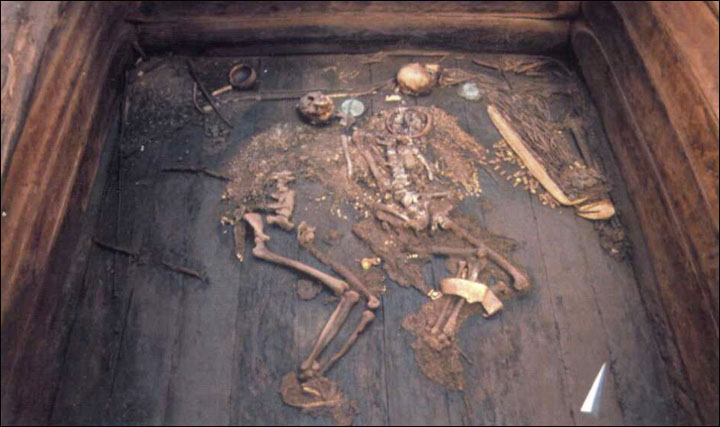
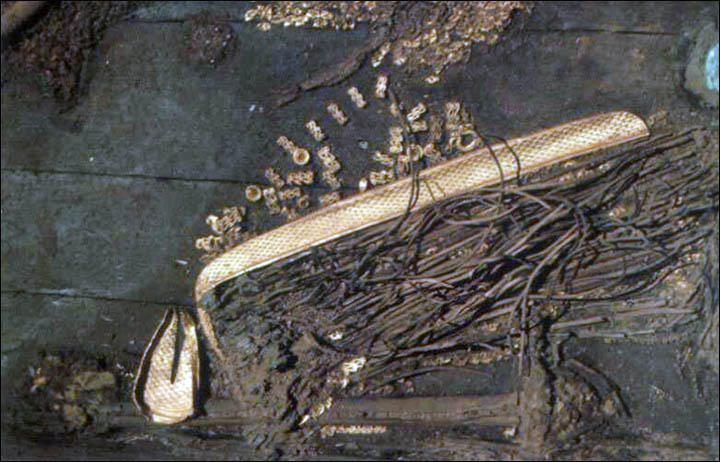
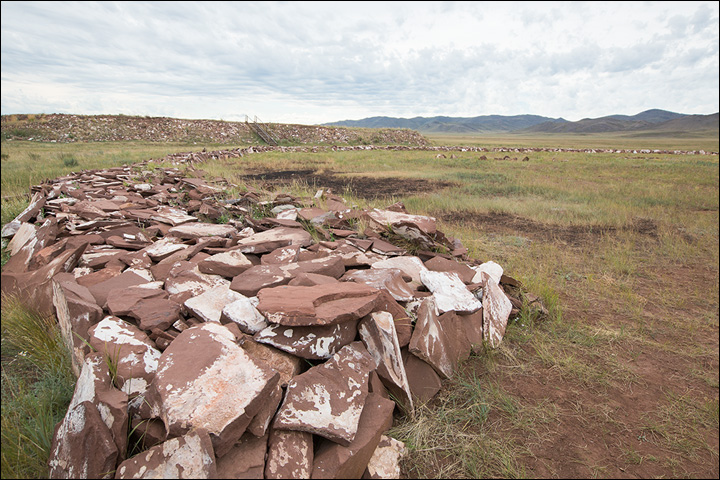
| Unknown warrior was found literally covered in gold alongside with his woman. Pictures: Konstantin Chugunov, Anatoli Nagler and Hermann Parzinger |
| The unknown monarch - a Siberian Tutankhamun - was entombed in this ancient necropolis with 14 horses, a defining symbol of wealth in these Scythian times; each animal was from a different herd. Alongside him lay the woman in his life, his queen or, as is suspected, his favourite concubine, but in any event a woman held in great esteem who was ethnically distinct from this monarch's retinue also buried alongside him which included 33 others, including five children. She was in all likelihood not alone in being sacrificed to accompany him to the afterlife... The most breathtaking aspect of this Tuvan find are the contents of the burial chamber of this royal couple - pictured here - located by archeologists some two or three metres beneath the surface. In all, some 9,300 decorative gold pieces were found here, not including the 'uncountable golden beads'. Put in another way, there was more than 20 kilograms of gold, including earrings, pendants and beads, adorning the bodies of the royal couple all made in what is known as Animal Art style. |
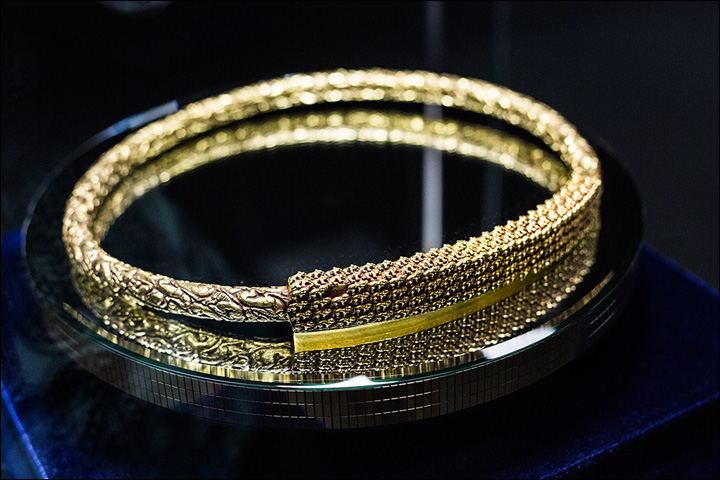
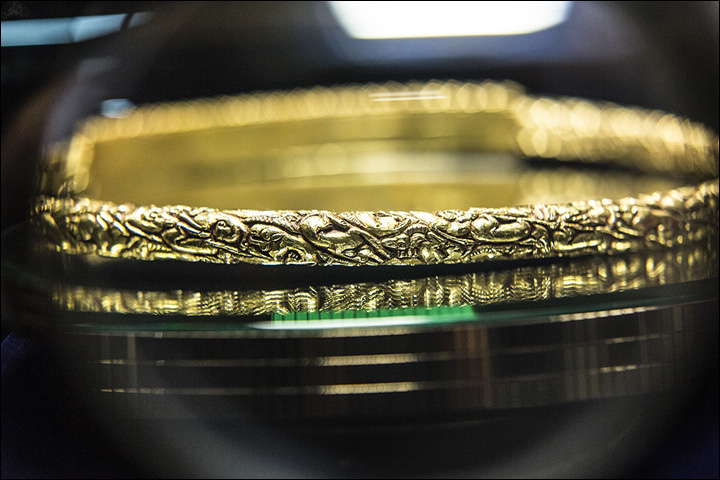
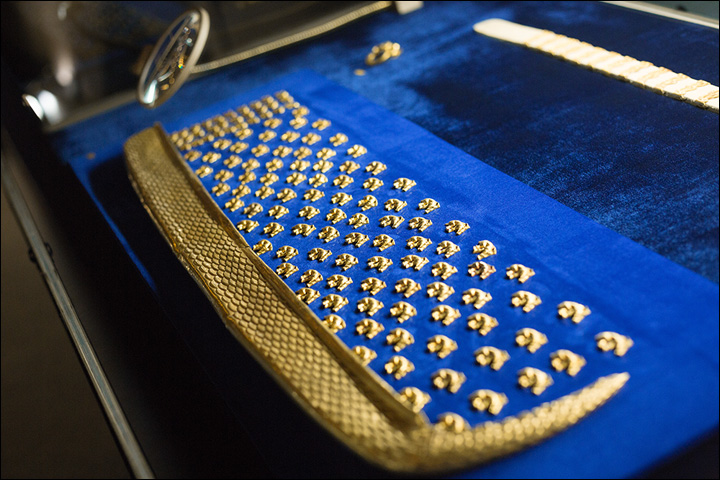
| The ancient ruler was buried with a heavy necklace made of pure gold and gold quiver with fish scale decoration. |
| Ancient robbers had sought to raid vast burial mound, just as they had successfully looted the neighbouring Arzhan 1 site, which was perhaps 150 years older. It could be that specially built 'decoy' graves threw these ancient looters' off the scent. Here in Arzhan 2, thieves had left a trail which archeologists unearthed but fortunately the raiders gave up shortly before reaching these treasures, which are made from iron, turquoise, amber and wood as well as gold. So valuable are they that it is rumoured these wondrous objects - now held mainly in local capital Kyzyl but also in St Petersburg - cannot be exhibited abroad because of the cost of insurance. The find has been described by Dr Mikhail Piotrovsky, director of the Hermitage Museum as 'an encyclopedia of Scythian Animal Art because you have all the animals which roamed the region, such as panther, lions, camels, deer...' It includes 'many great works of art - figures of animals, necklaces, pins with animals carved into a golden surface', he told The New York Times. 'This is the original Scythian style, from the Altai region, which eventually came to the Black Sea region and finally in contact with ancient Greece. And it resembles almost an Art Nouveau style.' |
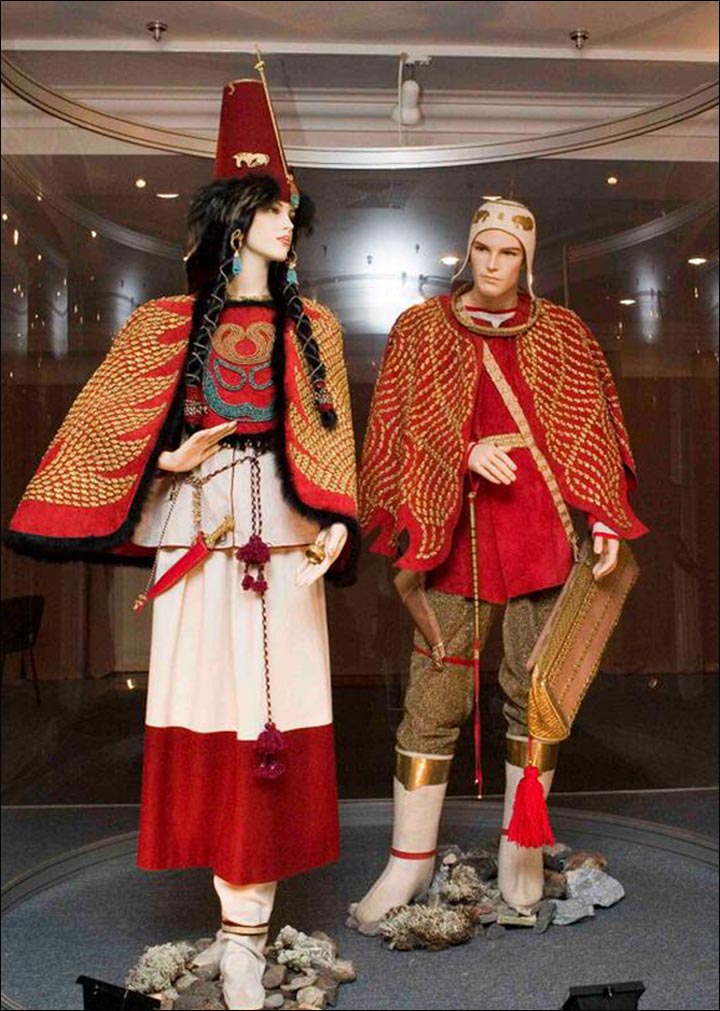
| The reconstruction of the costumes made by the experts from Hermitage Museum. |
| Covered with two layers of larch logs, the royal burial chamber was carefully constructed like a blockhouse and stood inside a second, outer burial chamber of the same construction. The four walls were presumably adorned by some kind of curtain. Long wooden sticks were found along the walls, which could have been used like curtain rails. The curtains themselves, as well as any other textile remains, were not preserved. On a carefully made boarded wooden floor - likely softened by felt - were the bodies of this sovereign and his companion. The skulls had dislocated from the bodies because they had probably been placed on a kind of pillow, now decayed. The ancient ruler was buried with a heavy necklace made of pure gold and decorated all over with the carvings of animals. His outer clothes, probably a kind of kaftan, had been decorated with thousands of small panther figures, each 2-to-3 centimetres in length, attached in vertical rows, also forming motifs such as wings on his back. |
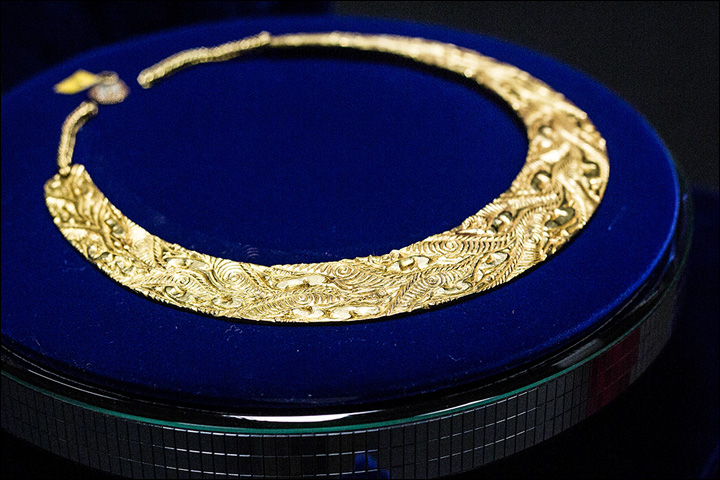
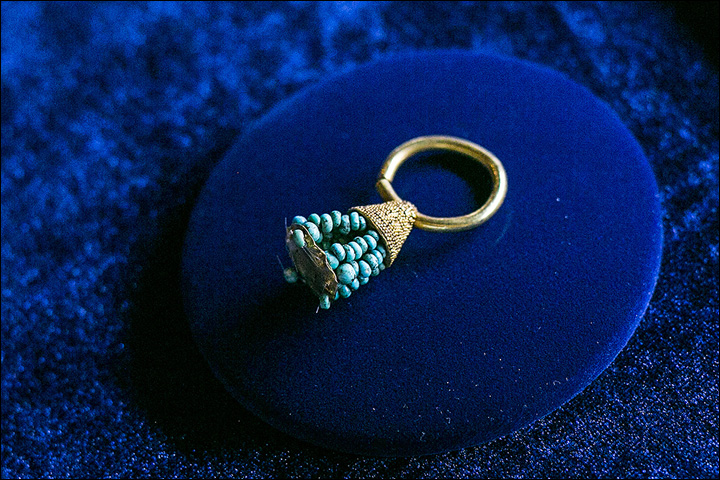
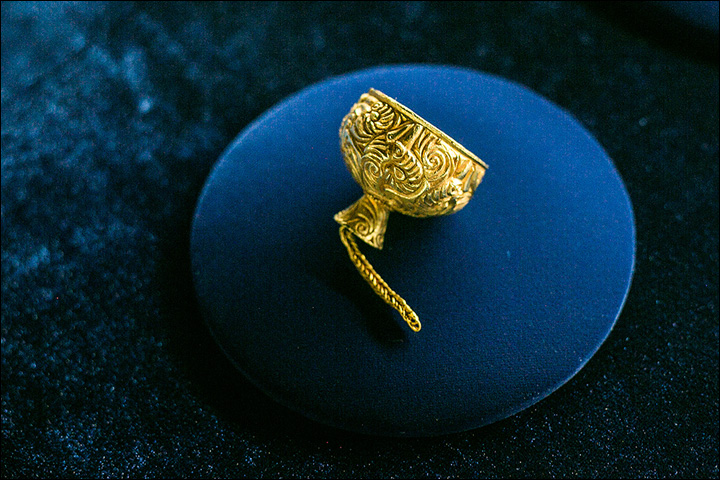
| A gold pectoral in Animal Style decoration, golden earring with turquoise and a miniature gold cup. |
| On his boots, maybe originally of felt or leather, thousands of mini-beads - in diameter only about 1 millimetre - had been stitched; on the upper part they ended in golden turndowns. Alongside and under the skull were gold plaques with animal-shaped inlays: four winged horses and one deer originally attached to the headgear. The total weight of his jewellery - including minute glass beads on his trousers - was 2 kilograms. The man's weaponry consisted of an iron dagger, poorly preserved, on his right hip. This was connected to the belt by a strap, and both had been decorated with numerous golden adornments. Beside the dagger was a miniature gold cup. On the left side of the deceased was a gold quiver with fish scale decoration. The wooden arrow shafts were painted in black and red. His arrow heads were made of iron, but also showed the remains of golden encrustation. The golden adornment on the belt - used for carrying his quiver into the afterlife - was extremely rich. Below the quiver lay the wooden bow itself, studded with pieces of golden decoration. Between the quiver and the north-eastern wall of the burial chamber were two picks, one of iron with golden encrustation. To the left of the man's head lay a bronze mirror. |
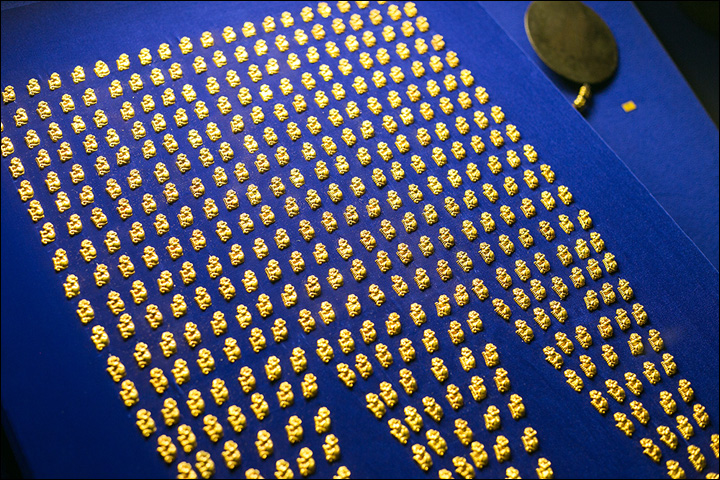
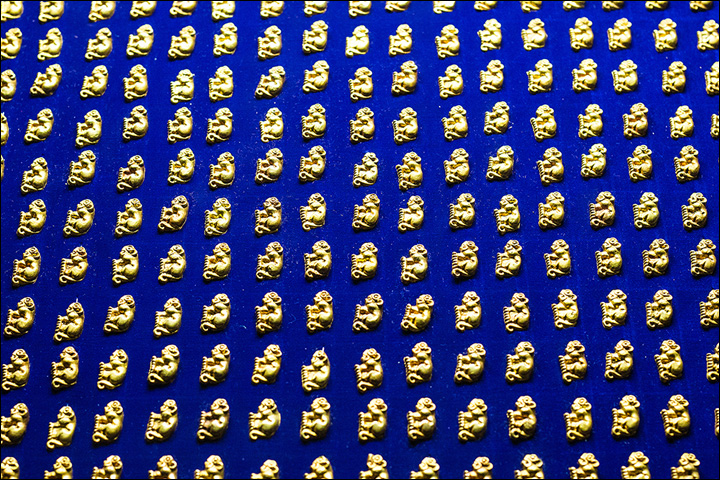
| His outer clothes, probably a kind of kaftan, had been decorated with thousands of small panther figures, each 2-to-3 centimetres in length. |
| A second, slightly larger bronze mirror was located to the left of the woman's head, a little bigger and with a gold handle. Below the woman's head were three gold plaques in the shape of animals - two horses and a mystical winged creature - associated with the woman's headdress. Beside her head was a pair of gold pins, decorated with carvings in Animal Art style. The decoration of the woman's dress corresponded to the man's kaftan: thousands of golden panthers form different motifs, again, notably, wings on her back. Around her breasts, archeologists found golden earrings and many small beads of gold, amber, garnet, malachite and other precious materials. Near her feet were thousands of mini-beads made of gold, which must have been fixed onto felt or leather boots which had been inlaid with golden ribbons and granulation. On her right hip hung an iron knife, poorly preserved but with numerous excellent gold belt adornments. Her wrists were adorned with gold bracelets. Here, too, lay two bronze kettles, seen as exceptionally valuable for these times. In the western corner of the burial chamber were three large amber beads, a wooden cup with a golden handle, a gold comb with wooden teeth, and a heap of various seeds. Within the heap of seeds was a gold pectoral in Animal Style decoration and a small bronze cup, still inside a small leather bag. |
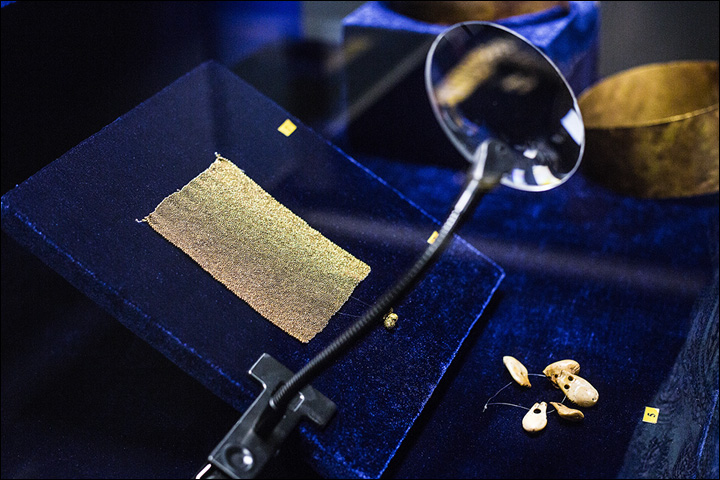
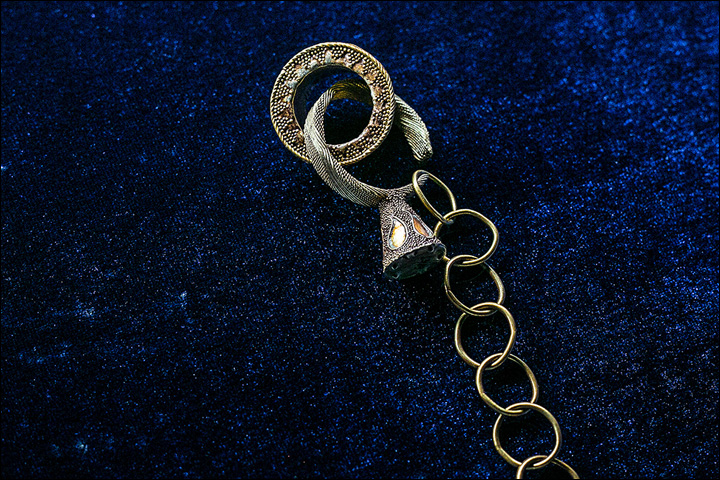
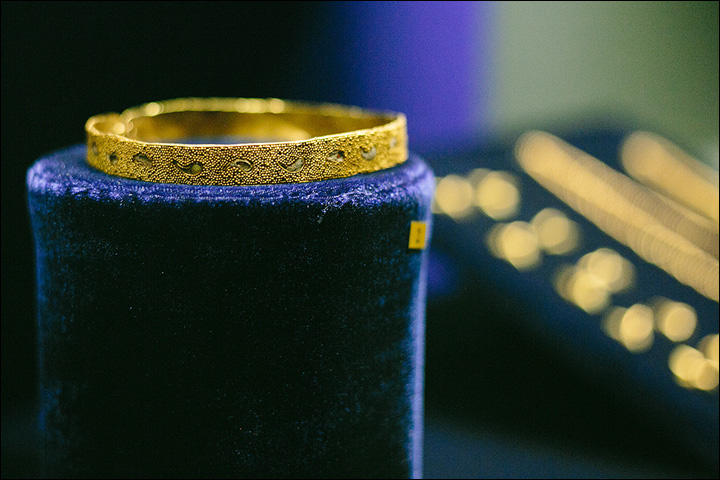
| 'It's hard to imagine that these fine pieces were made by nomads living in tents.' |
| In other burials, which surrounded the prominent couple, bronze knives, an axe-type weapon, known as a Raven's beak, arrowheads, bronze mirrors, belts, and much jewellery - beads made of glass, stone, amber, and golden earrings - were found. So too were fragments of cloth - felt, fur, and fabric. Here too were discovered bridle sets made of bronze, mane ornaments and tail decorations cut from gold sheet. What can we discern of the personal stories behind these ancient royals and their entourage found in Uyuk hollow, northern Tuva, and excavated by a joint Russian-German team between 2001 and 2004? Professor Konstantin Chugunov, highly respected senior researcher at the world famous Hermitage Museum in St Petersburg, who headed the project, said DNA analysis of the group indicated those buried here were from the Iranian ethno-linguistic group. According to the analysis of strontium isotopes in the bones, all those buried were locals except for one person - the 'queen', and it gives reason to think about dynastic marriage,' he said. |
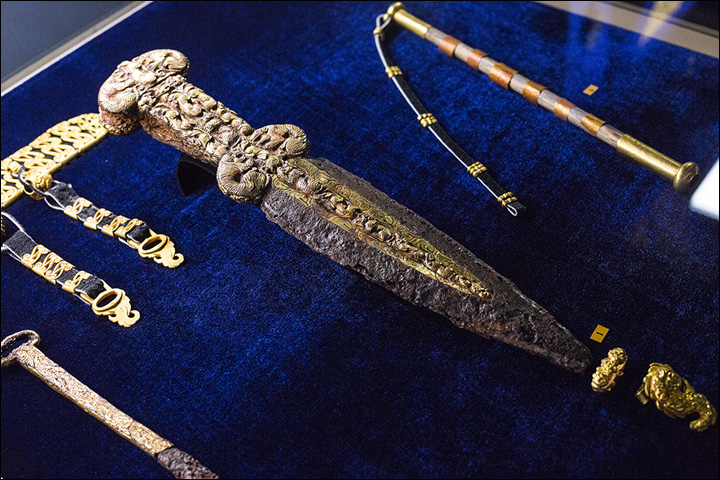
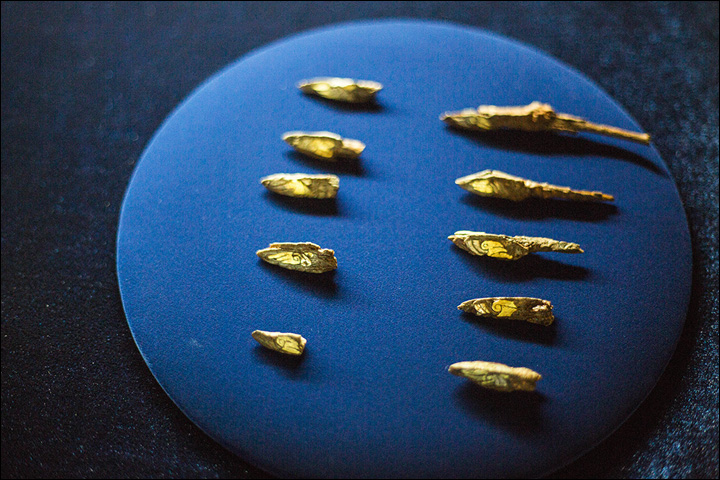
| Weapon: an iron dagger and iron arrowheads with golden encrustation. |
| Totally 35 people - 16 men, 13 women, five children along with bones which cannot be identified by gender, were buried here, as were 14 horses. The 'king' was between 40 and 50 years old and analysis of his remains revealed that he died of prostate cancer. 'This is the earliest documentation of the disease,' said Michael Schultz, a paleopathologist at the University of Gottingen. It is believed that in the last years of his life, this potentate could not have walked. His female partner, accorded pride of place alongside him, was around 30 years old. Who was she? We don't know if the woman was a queen or a concubine,' said Professor Hermann Parzinger, president of the Prussian Cultural Heritage Foundation, and a joint leader of the excavations, 'but since their ornaments were similar, both must have had high status.' No cause of death can be detected for her, leading to a theory that she could have been poisoned or strangled, to be buried beside her liege, and to travel with him into the next world: willingly or not, she was a human sacrifice, according to this version. 'Maybe she was poisoned,' said Chugunov, 'or maybe she chose to die to be with her husband.' We may never know how she died, by natural causes around the same time as her master or in more sinister fashion, but others in the tsar's entourage certainly had gruesome demises. |
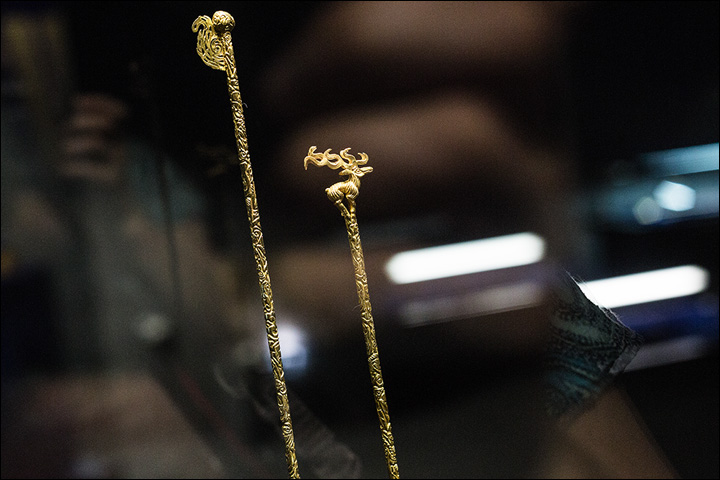
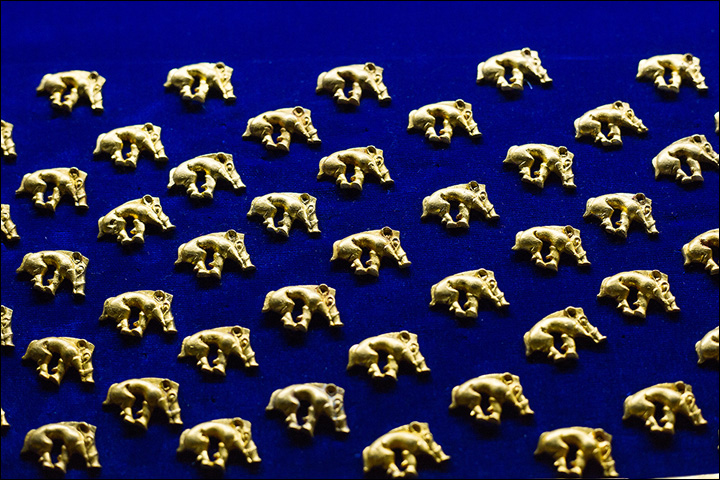
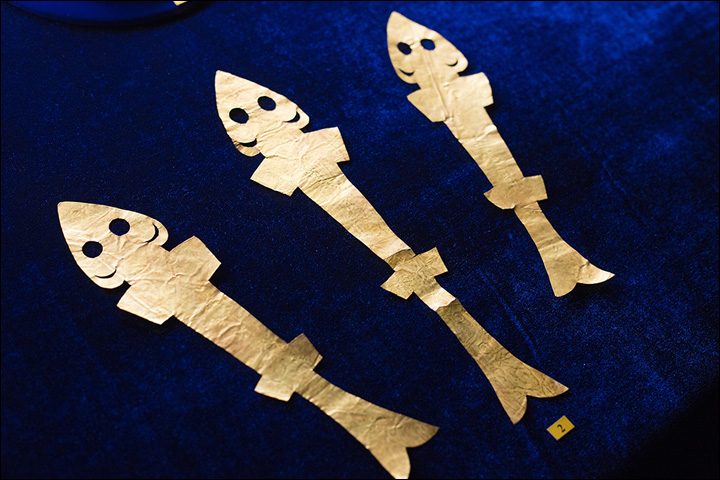
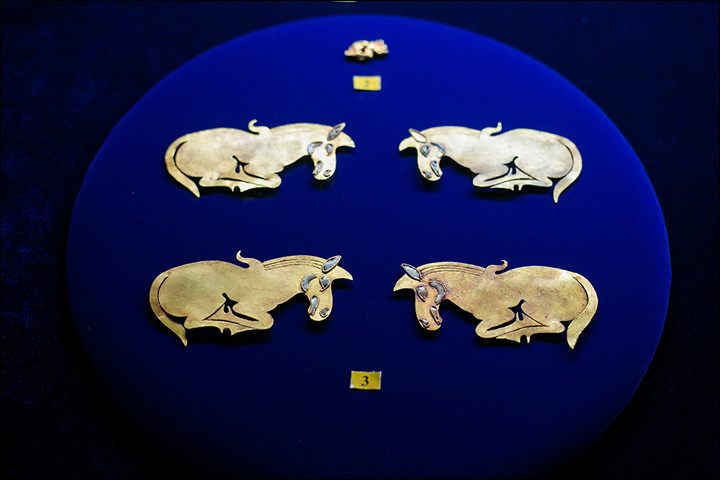
| Early Scythians were people who knew good artwork when they saw it, and used contacts to obtain, or commission, jewellery and decorations. |
| The scene archeologists uncovered here appears to match with remarkable accuracy a description by Herodotus of the macabre Scythian burial rite. 'Based on accompanying burials, we also found evidence of phenomena described by Herodotus when the living would follow the deceased,' Parzinger has explained. 'Herodotus wrote that when a military leader died, his close circle - wife (or concubine), bodyguards, advisers, servants - were killed. As they were the property of the leader, they had to follow him to the tomb. And we identified particular evidence of their murder.' Herodotus, who lived later, from 484 BC to 425 BC, wrote: 'The body of the king is laid in the grave, stretched upon a mattress. Spears are fixed in the ground on either side of the corpse and beams stretched above it to form a roof. 'In the open space around the body of the king they bury one of his concubines, first killing her by strangling, and also his cup-bearer, his cook, his groom, his lackey, his messenger, some of his horses... and some golden cups, for they use neither silver nor brass.' It is believed that when the king died, he was mummified and his body travelled for 40 days across all his lands. And all expressed their sorrow. Then at some sacred place a burial mound was constructed and his entire entourage were slaughtered and buried there. |
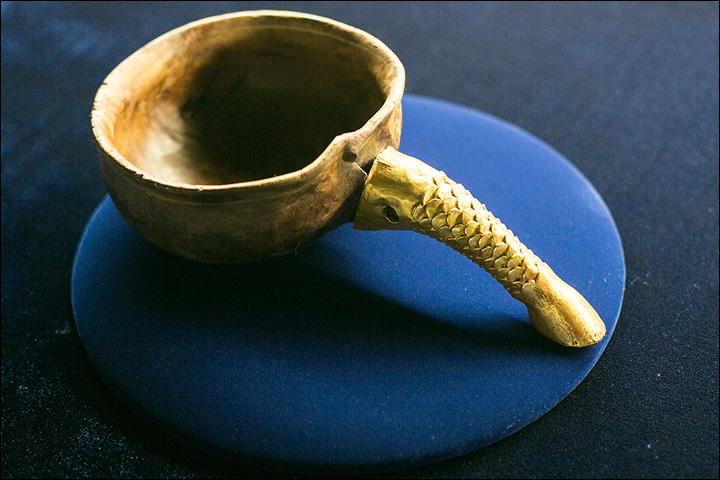
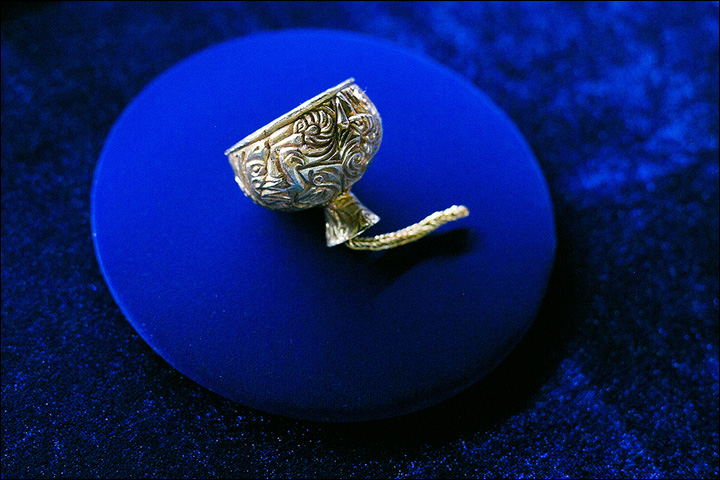
| Cups: wooden cup with a golden handle and small golden cup. |
| Herodotus did not describe how the ruler's entourage were killed. While the queen or concubine shows no sign of a violent death - the assumption is that she was poisoned - one woman's skull in Arzhan 2 was pierced four times with a war pick. A man's skull still retains the splinters from a wooden club used to kill him. In some cases archaeologists see evidence of blows to the head with kind of poleaxe: in other case, they suppose strangulation or poison. Separately, on these human remains was found evidence of 'battlefield surgery' conducted on these warriors during earlier conflicts. Next to the burial mound, to the north, was found a separate burial where 'chipped' human and horse bones were mixed. A 'guess' is that this fits another Herodotus description of the burial mound being guarded by dead horses pulling wagons with their wheels removed on which were placed dead horsemen. The Greek historian described 50 young men, who were set around the mound. Those, who made the burial, went away and the mound remained. The corpses of the horses and riders were pecked by birds, eaten by animals, and all this decayed. |
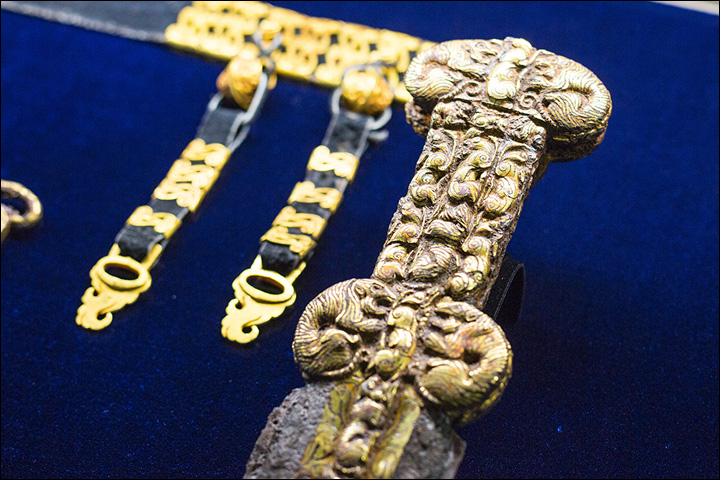
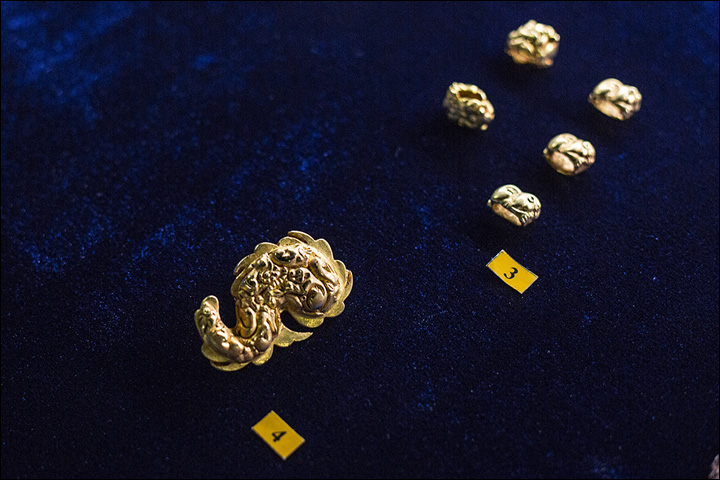
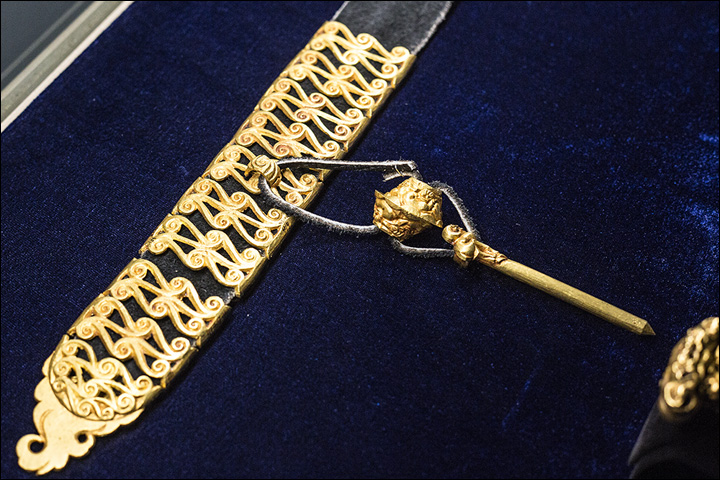
| Decorations on the akinak - or short sword - show similarities to patterns used in Eastern Zhou (Eastern China). |
| More can be understood about these nomads from the riches lying beside this noble couple, although these ancient people left no written records, and hardly any sign of settlements that - some archeologists suspect - must have existed. A royal burial such as this gives the 'quintessence of information' because the achievements of the culture at the time were laid to rest with the dead king, it has been said. As Parzinger has said: 'It's hard to imagine that these fine pieces were made by nomads living in tents.' Chugunov concurs: 'In Arzhan 2, the gold jewellery was clearly not made by nomadic artists.' They fought and pillaged but as Dr Anatoil Nagler, from the German Archeological Institute, told National Geographic: 'The people were excellent craftsmen. This puts the Scythian quality of life in a new light. It rejects the stereotype that Scythians were just wild horsemen and warriors, migrating and destroying other people. They had a high level of cultural development.' Or so it seemed at the time when the discoveries were first made. Now it is seen as more likely that these early Scythians were people who knew good artwork when they saw it, and used contacts to obtain, or commission, jewellery and decorations that matched their needs and tastes. Not that anyone was meant to see these treasures encased in the burial tomb. |
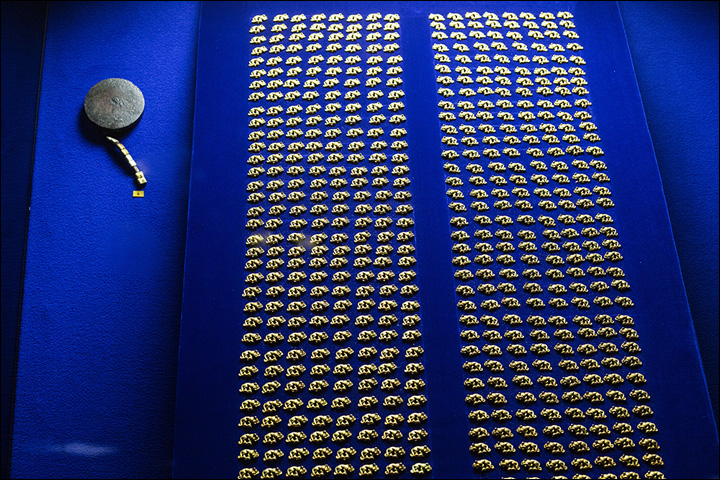
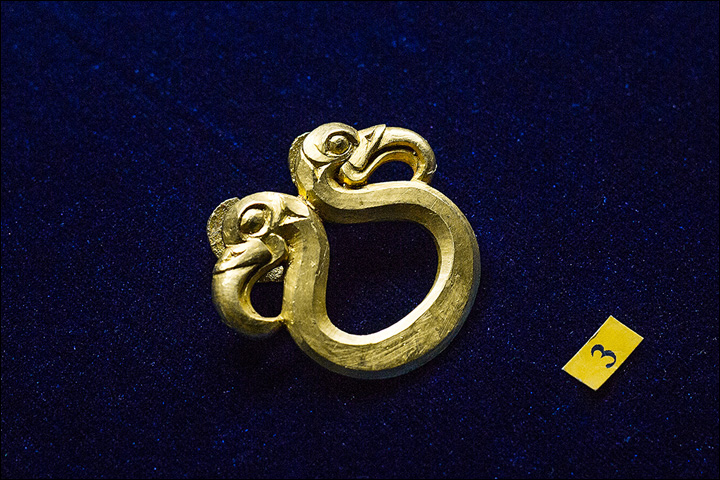
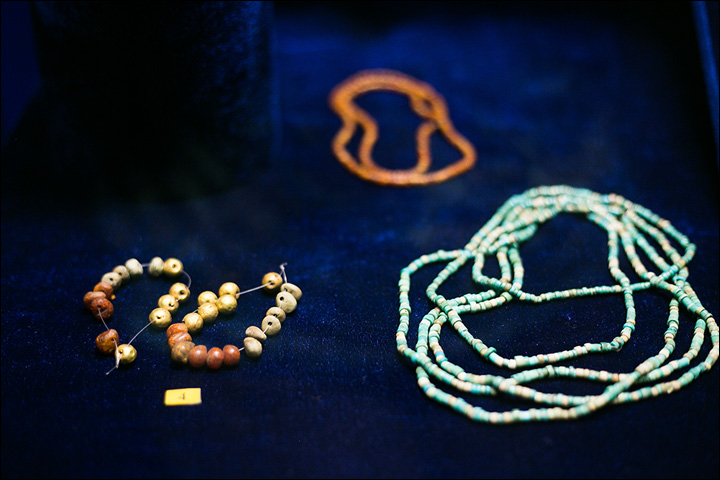
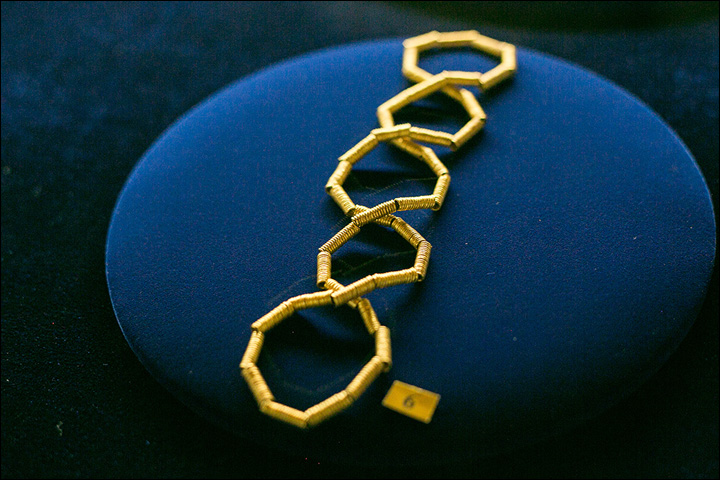
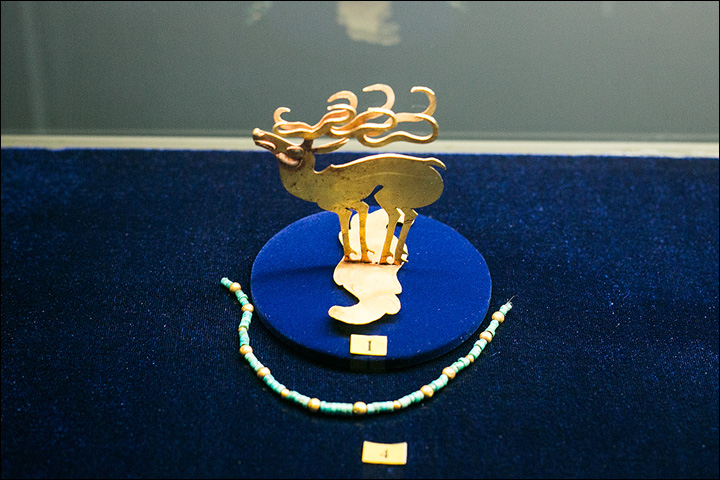
| The gleaming riches no-one was meant to see. |
| Some probably originated on the territory of what is now present-day China; others owe their origins to the Near East, with more seemingly made by Scythians in non-nomadic settlements. Some treasures came from a distance of between 4,000 and 5,000 kilometres from this burial mound, yet at this point there were no contacts with the Ancient Greeks. Even so, the treasures suggest the lost civilisation of Scythians were culturally more advanced that was once supposed. The experts surmise that it was Scythian craftsmen who cast the daggers, arrowheads, and gold plaques found at this site. Decorations on the akinak - or short sword - show similarities to patterns used in Eastern Zhou (Eastern China) at around the same period. Bronze jars found in Inner Mongolia are compatible to a small bowl with horizontal a loop-like handle from the main burial in Arzhan 2. The same applies to methods used in embroidery and the manufacture of earrings, the latter resembling a technique used close to the Aral Sea, some 3,600 km distant. Remains of fruit and seeds of plants found at Arzhan 2 had also come from far afield. |
http://siberiantimes.com/science/casestudy/features/f0212-focus-on-tuva-stunning-treasures-and-macabre-slaughter-in-siberias-prehistoric-valley-of-the-kings/ - http://siberiantimes.com/science/casestudy/features/f0212-focus-on-tuva-stunning-treasures-and-macabre-slaughter-in-siberias-prehistoric-valley-of-the-kings/
------------- What a handsome figure of a dragon. No wonder I fall madly in love with the Alani Dragon now, the avatar, it's a gorgeous dragon picture.
|
Posted By: red clay
Date Posted: 07-Mar-2016 at 17:09
Wow! the craftsmanship is incredible. I've never worked in Gold, couldn't afford it when I was in Uni. However I did enough silver to fully understand the investment, not in gold, but in time.
The time invested in these items, man hours, probably monopolized most of the artisans working at the time.
Nice find Alani.
-------------
"Arguing with someone who hates you or your ideas, is like playing chess with a pigeon. No matter what move you make, your opponent will walk all over the board and scramble the pieces".
Unknown.
|
Posted By: Arthur-Robin
Date Posted: 08-Mar-2016 at 18:04
Man that post of mine a few above is embarrassingly bad/wrong.
Interesting pics & some info in the recent last posts.
I wish it wasn't orthodox establishment academia etc elite that were the ones with the most power, freedom and resources etc in history/archaeology/scholarship (though ok some of them have done alot of study & work in Uni etc). I wish i had the time etc to research this and other things abit more.
Germans, Prussians & Russians....
We only see all the gold etc pictures, no one see the slaves etc.
The gold makes one think of Nibelungs or Slatababa. Some in the first post is abit like Celtic cauldron pictures.
The "Scythians" seem to have ranged over a huge area from Tuva in Mongolia/Altai to Russia/BlackSea etc. Are they sure they aren't confusing different peoples (Scythians, Tocharians, Turanians, Huns, Argippaei, "Griffins", Sarmatians, etc)?
Strange that orthodox unfairly bash/brand sources like Herodotus as unreliable when we cite them but then they confirm them as accurate when it suits them.
p.s. I always wonder/worry what they could be doing with the dna/genes from all these ancient & medieval digs. (Yours Truly, Frankenstein, at Jurassic Park.)
|
|

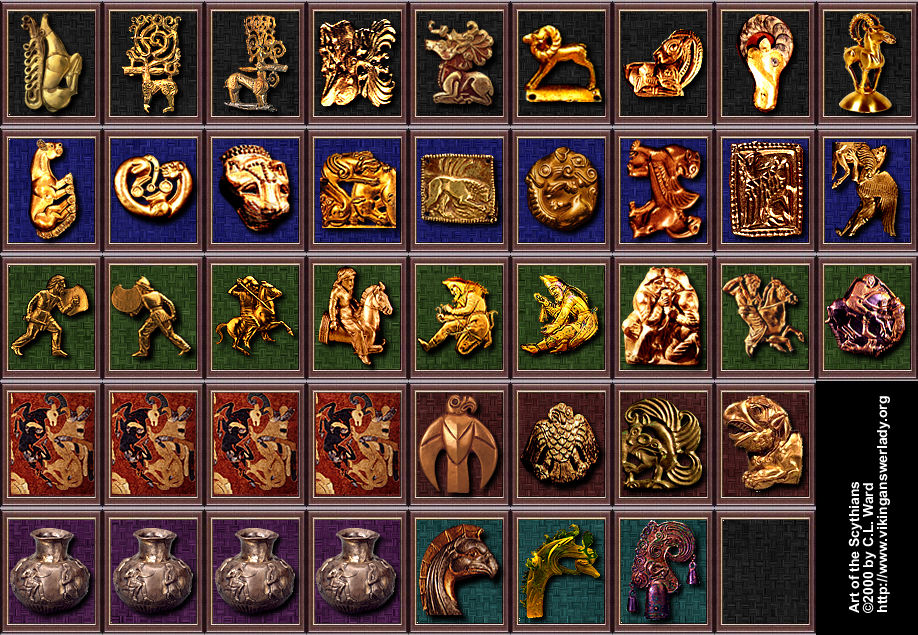

 http://www.pitt.edu/~haskins/sites/slides-group1.html - Collection Group 1
http://www.pitt.edu/~haskins/sites/slides-group1.html - Collection Group 1  http://www.pitt.edu/~haskins/group2/group2a.html - Collection Group 2
http://www.pitt.edu/~haskins/group2/group2a.html - Collection Group 2  http://www.pitt.edu/~haskins/group2/group3/group3.html - Collection Group 3
http://www.pitt.edu/~haskins/group2/group3/group3.html - Collection Group 3  http://www.pitt.edu/~haskins/group4/group4.html - Collection Group 4
http://www.pitt.edu/~haskins/group4/group4.html - Collection Group 4  http://www.pitt.edu/~haskins/group5/group5.html - Collection Group 5
http://www.pitt.edu/~haskins/group5/group5.html - Collection Group 5  http://www.pitt.edu/~haskins/group6/group6.html - Collection Group 6
http://www.pitt.edu/~haskins/group6/group6.html - Collection Group 6  http://www.pitt.edu/~haskins/group7/group7.html - Collection Group 7
http://www.pitt.edu/~haskins/group7/group7.html - Collection Group 7 
